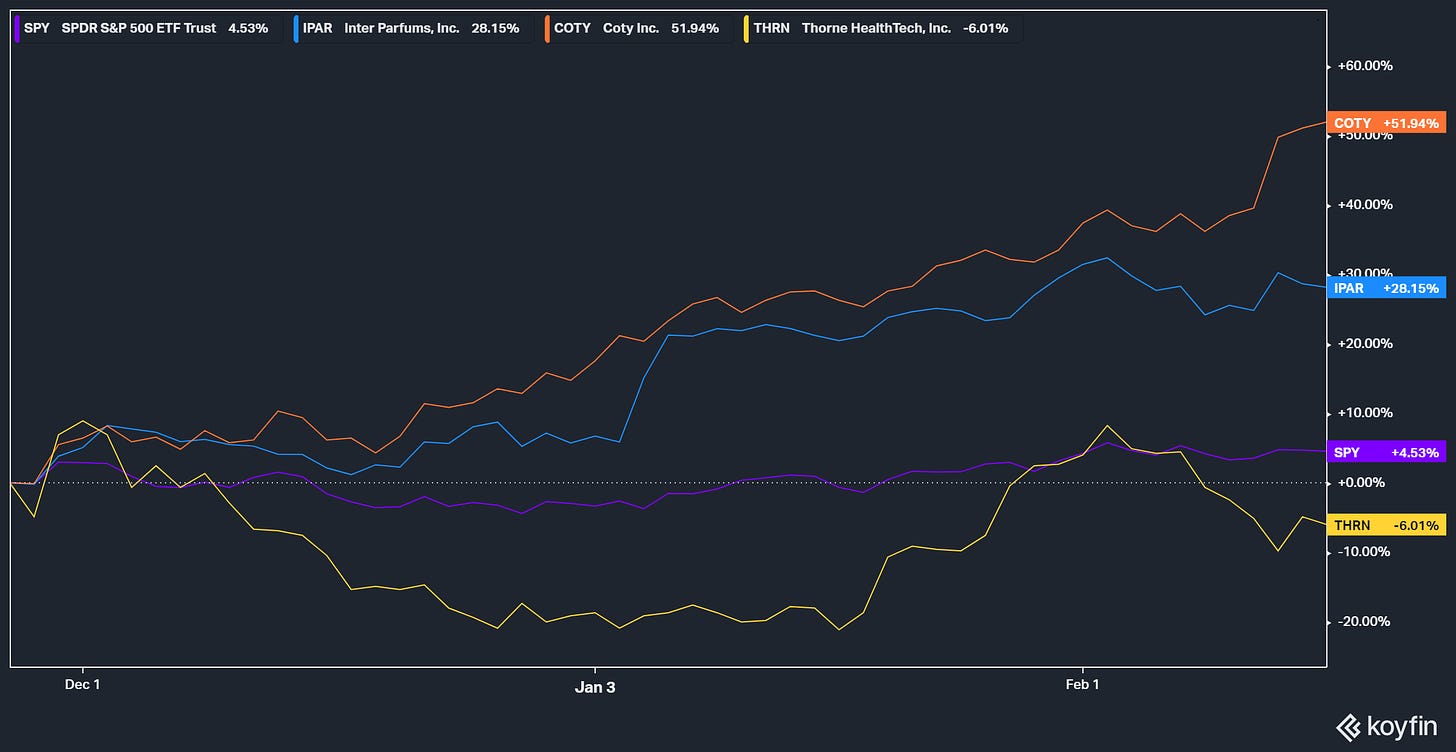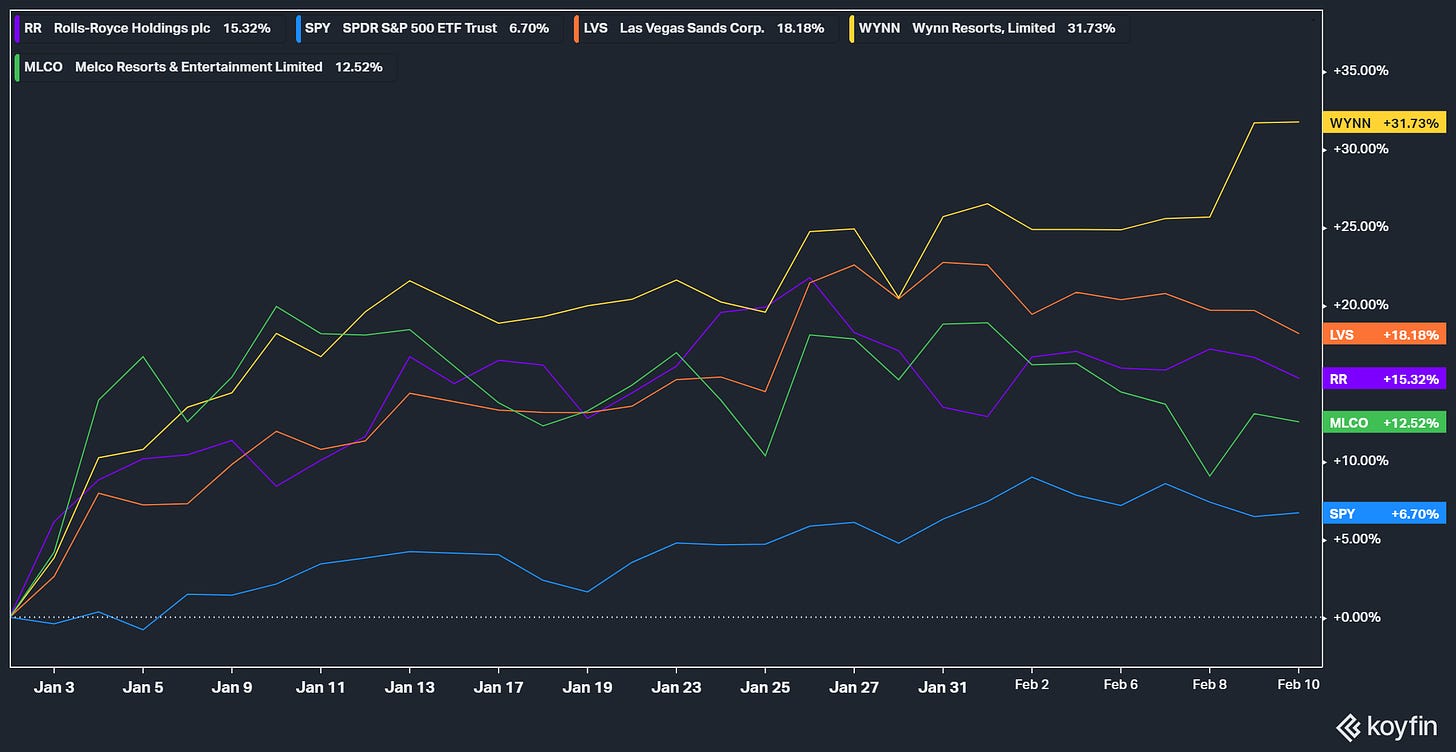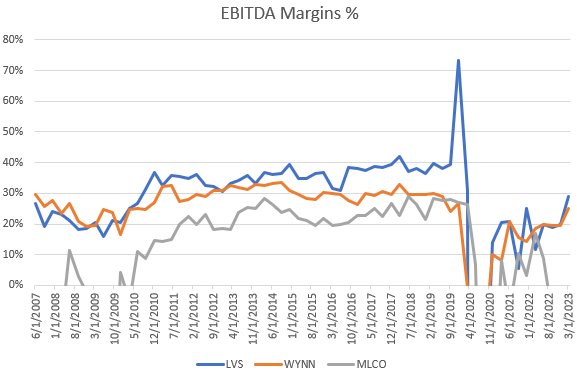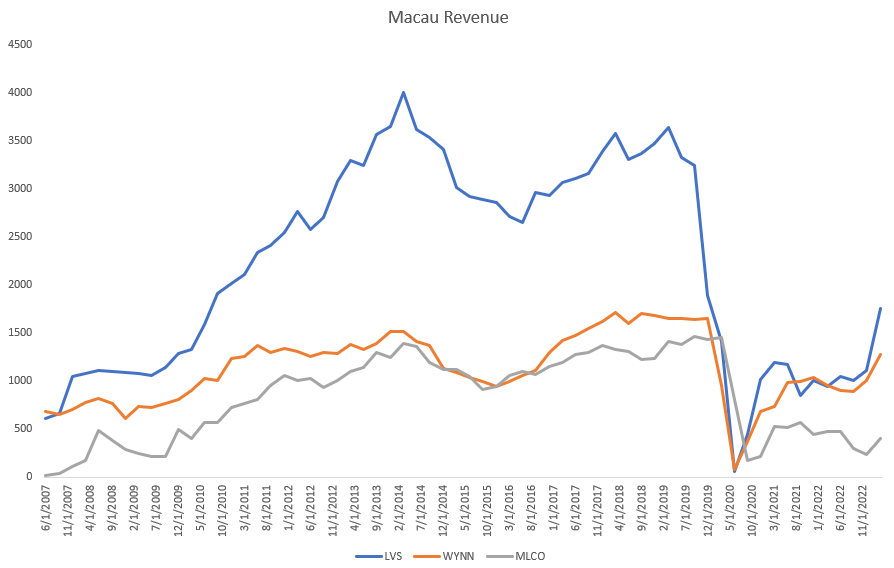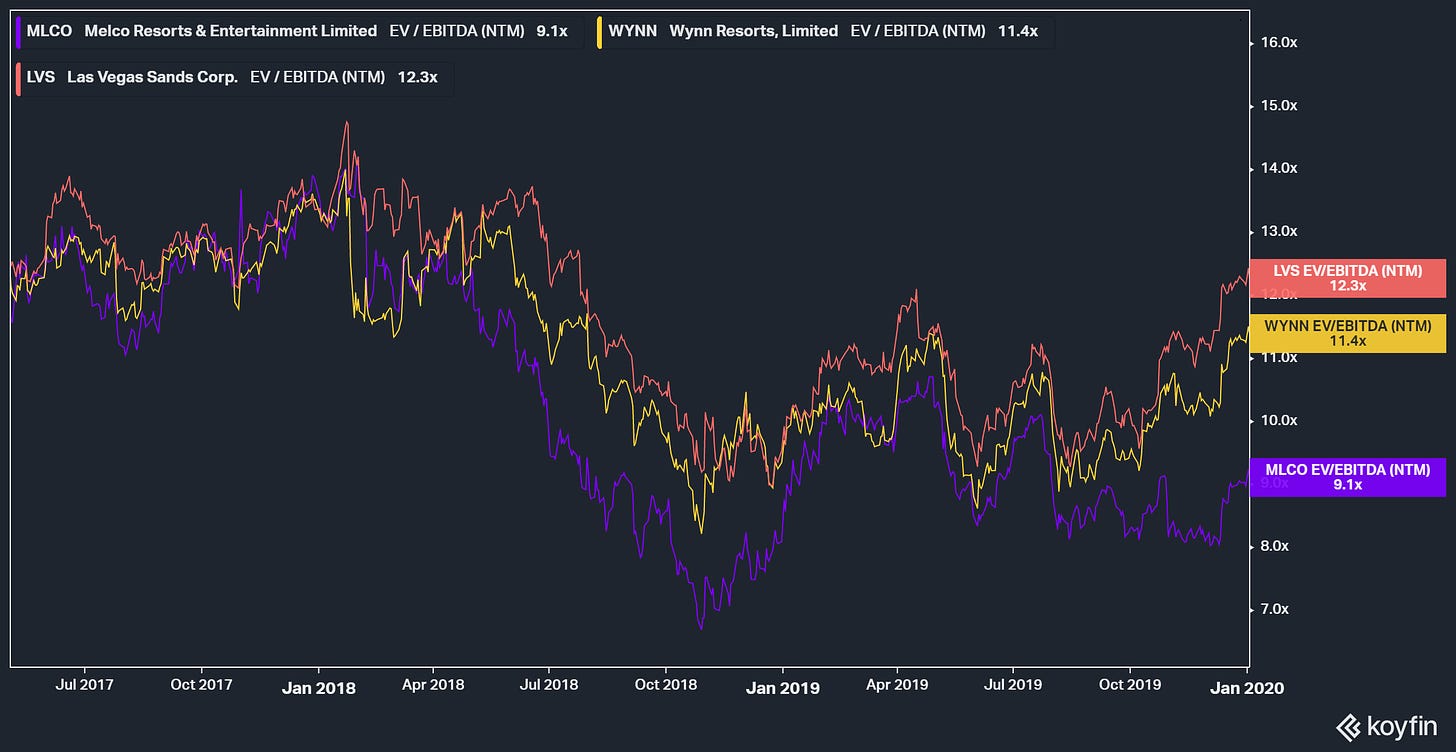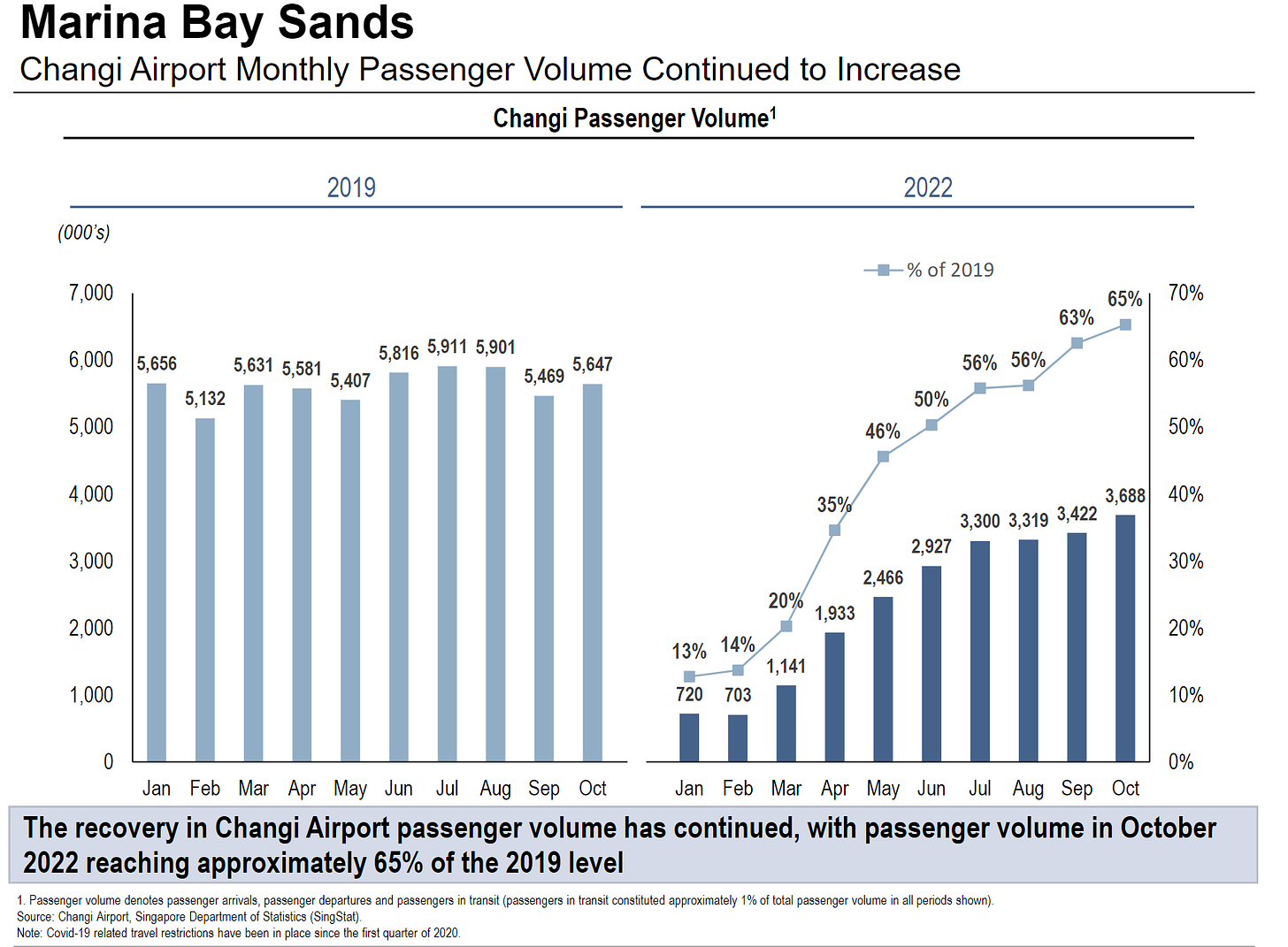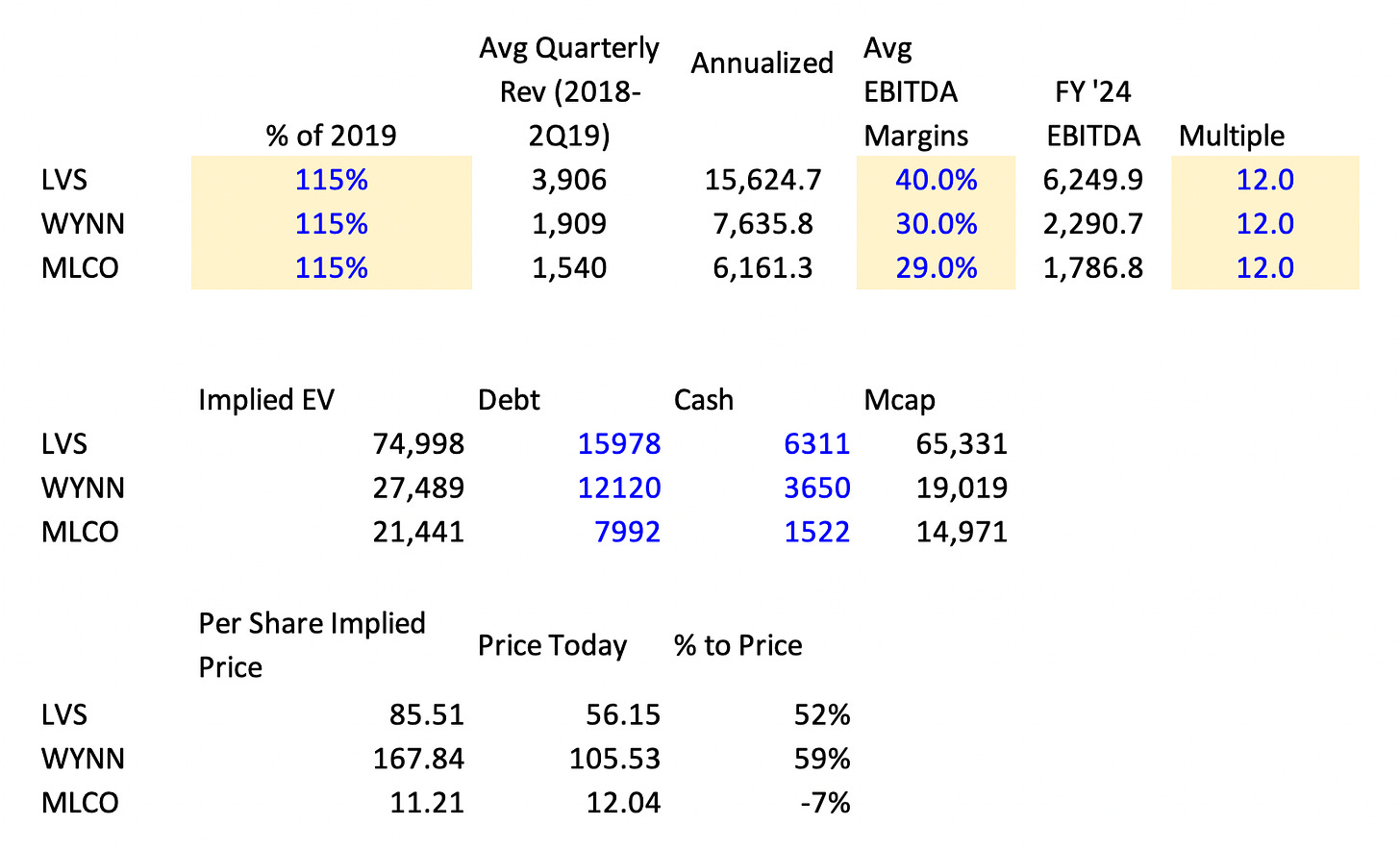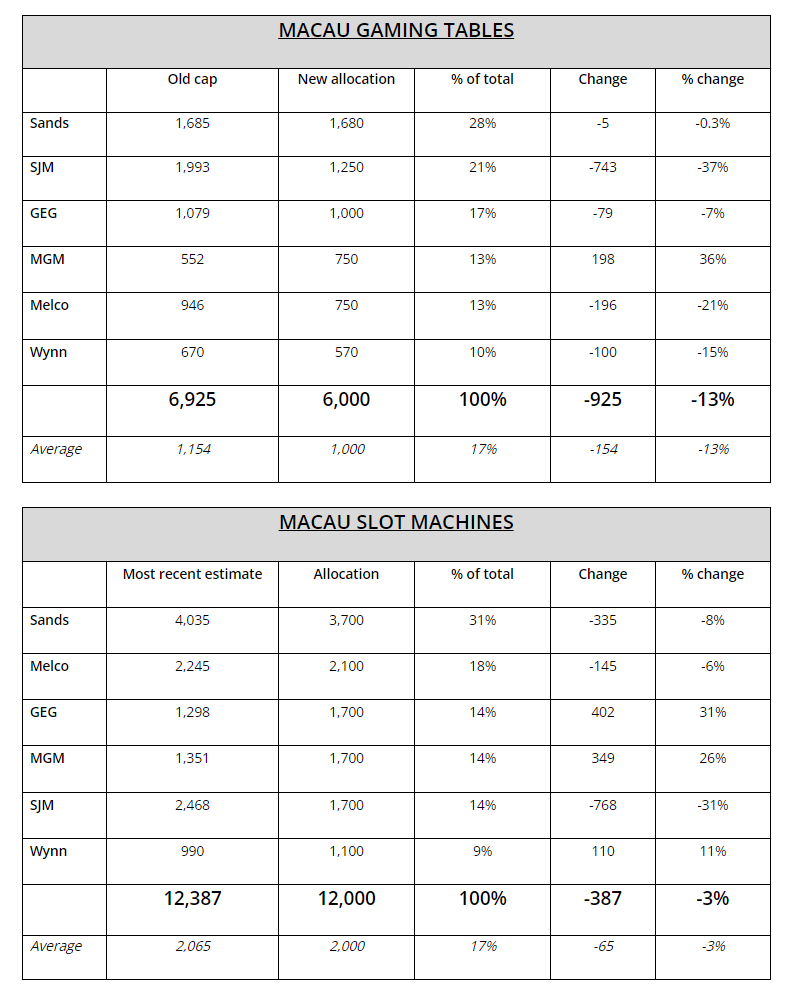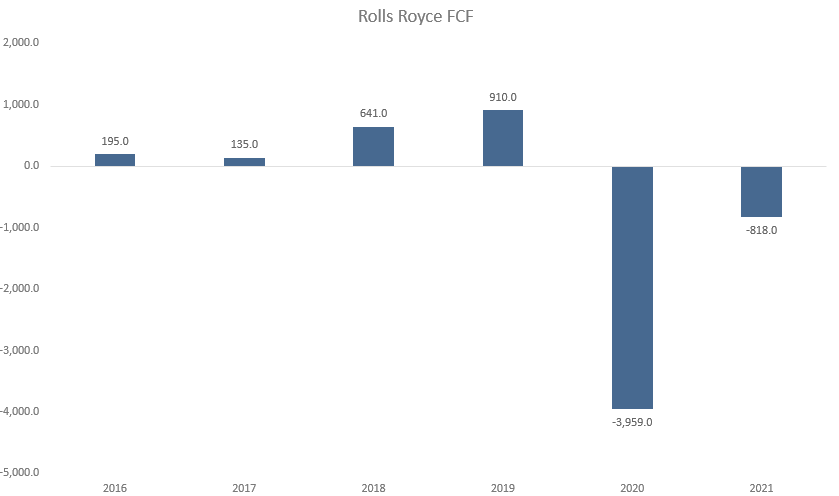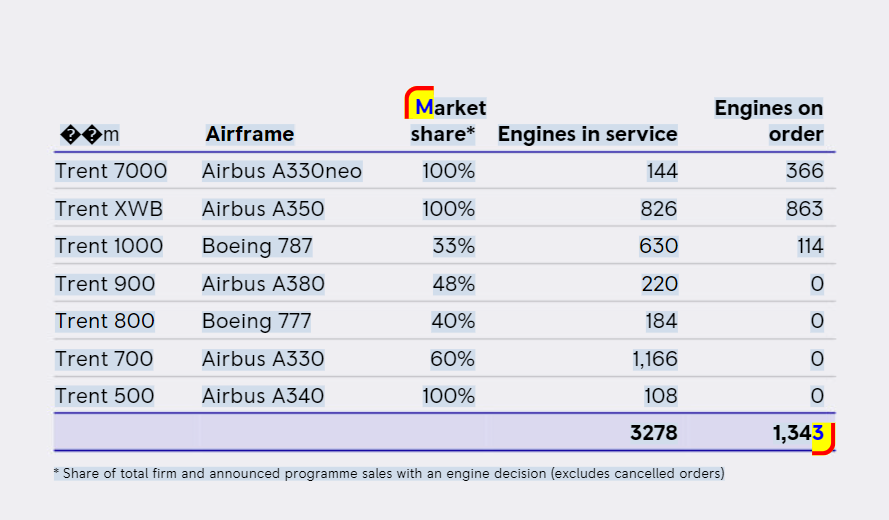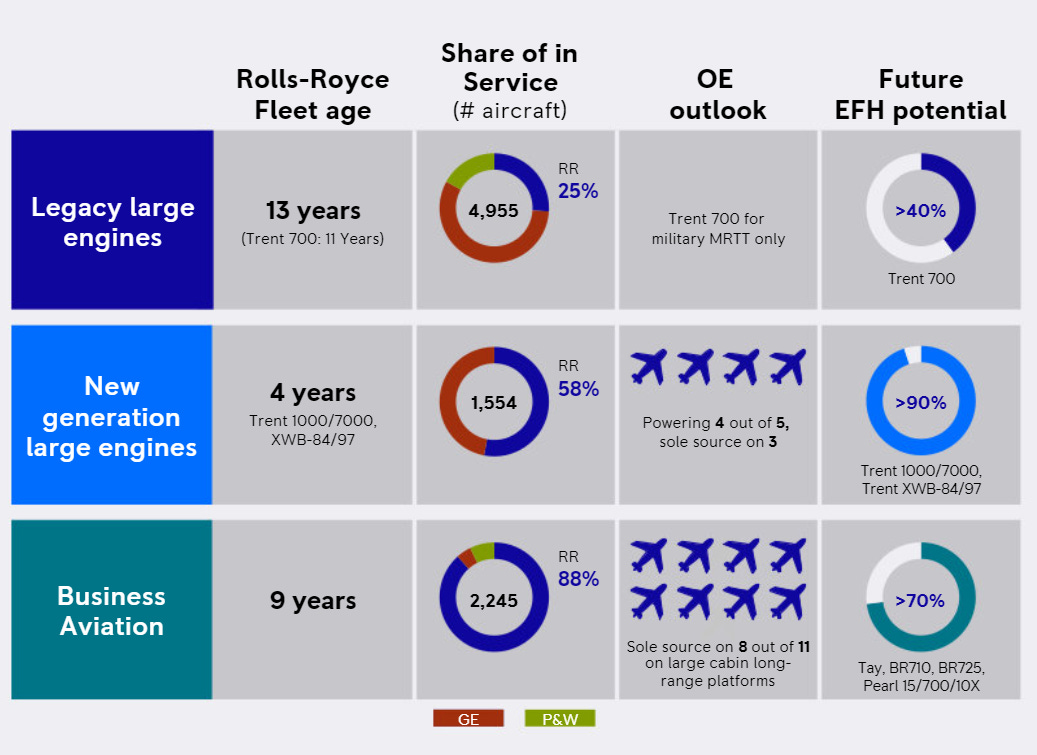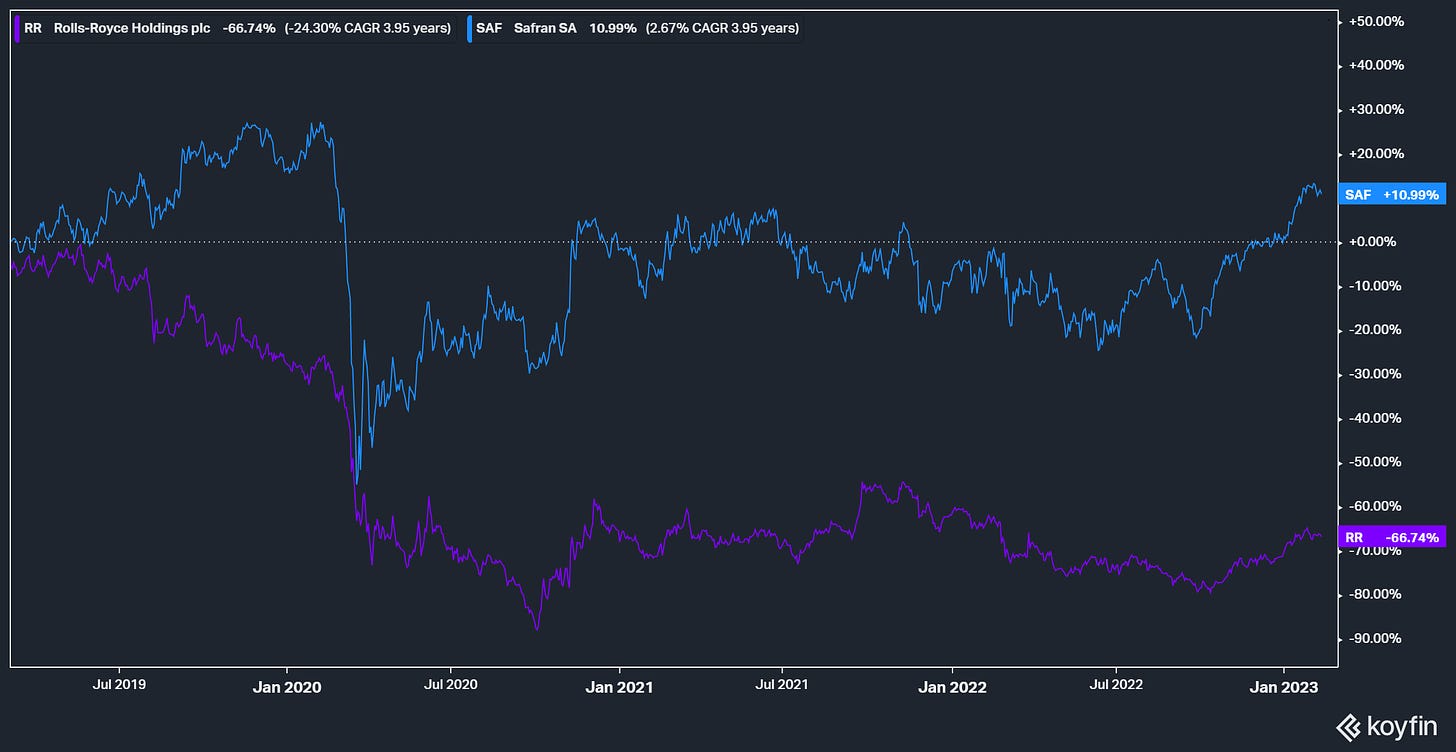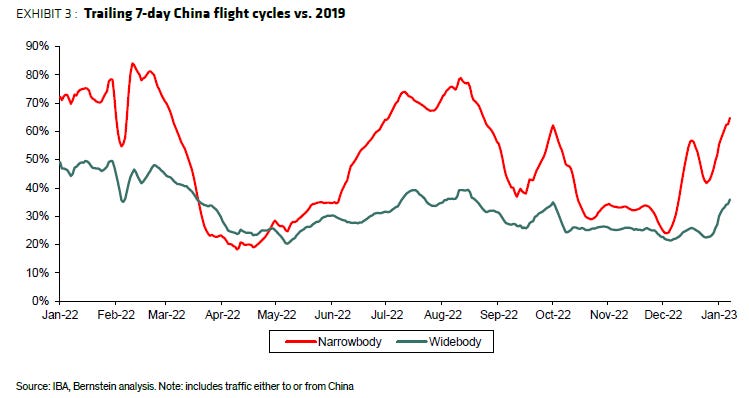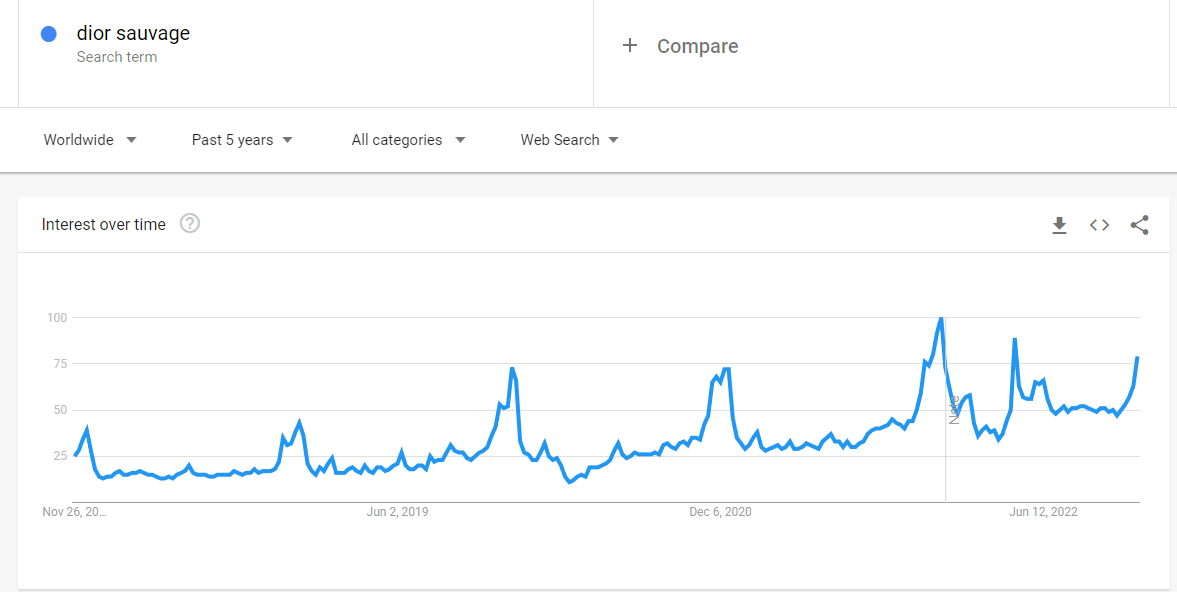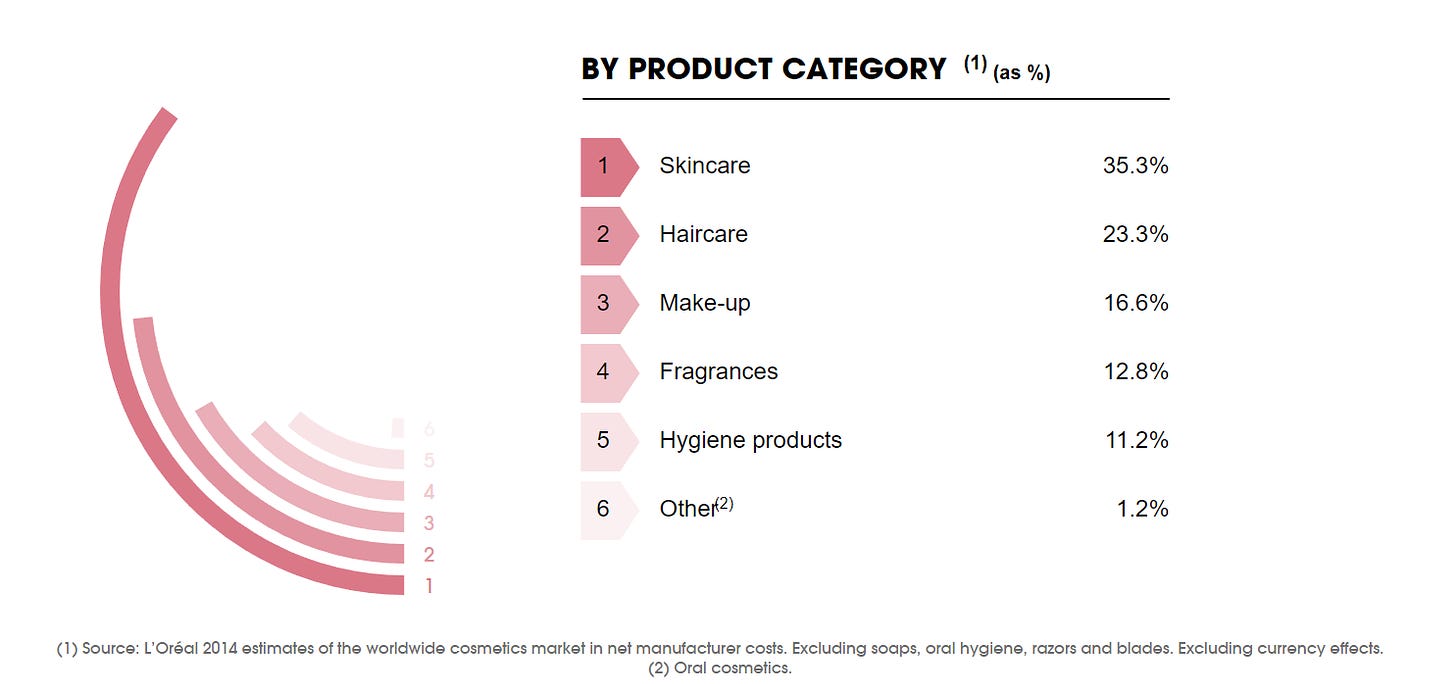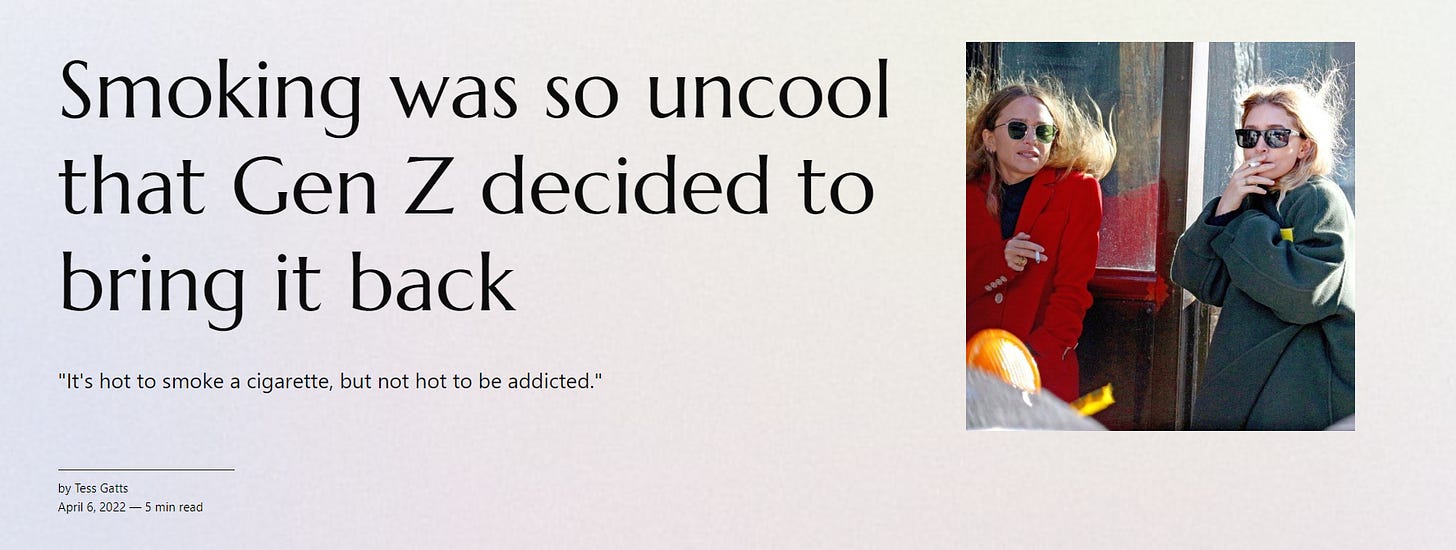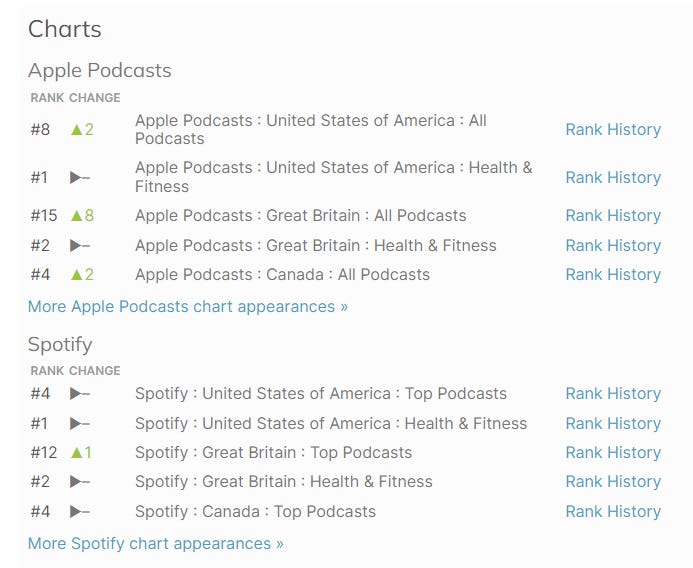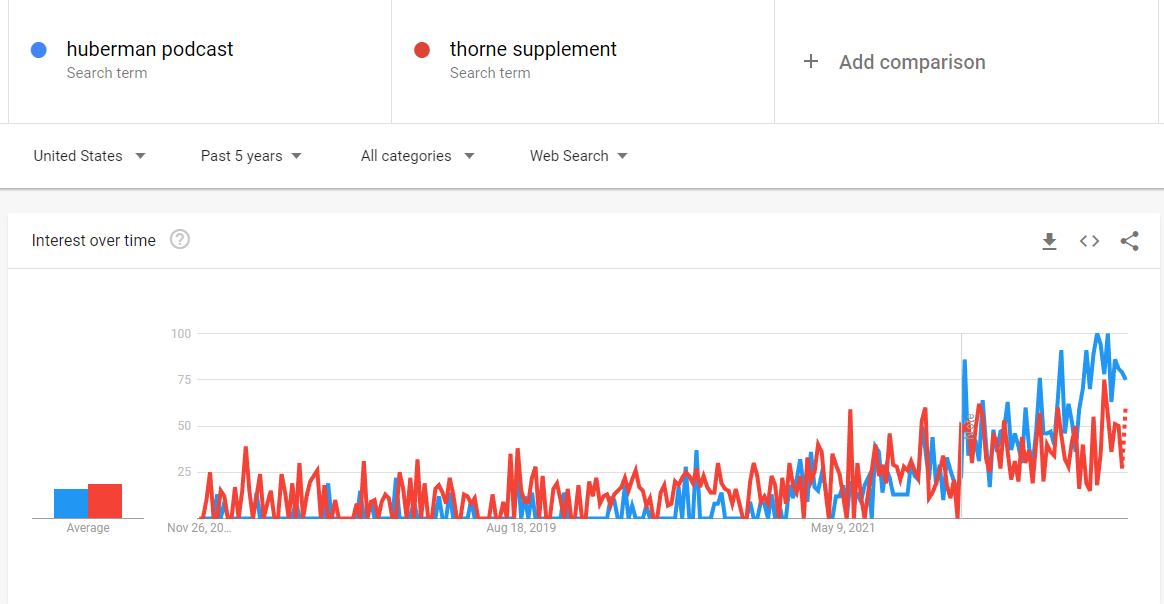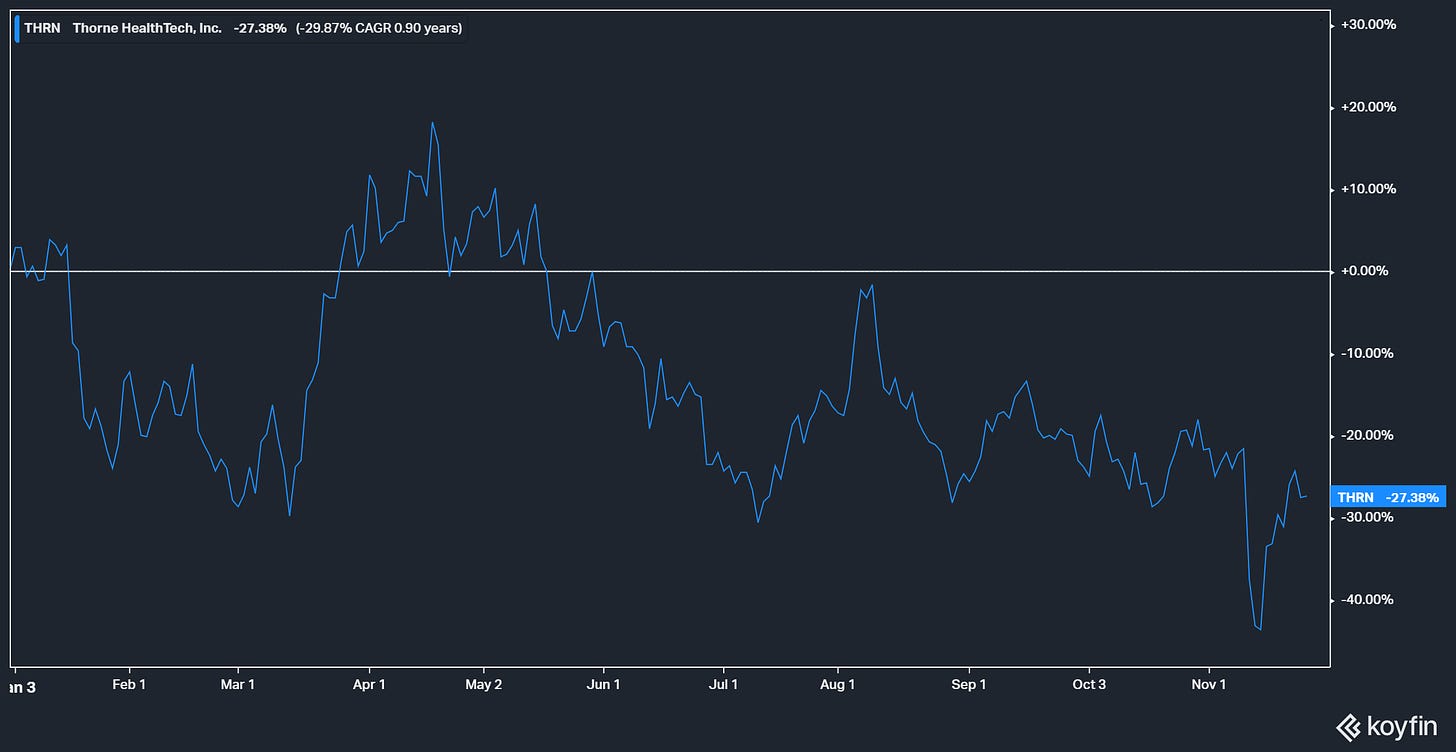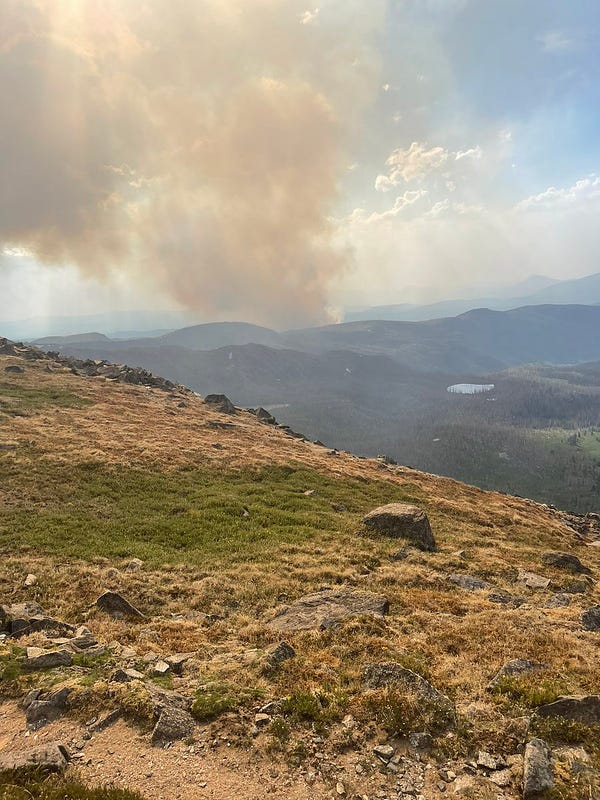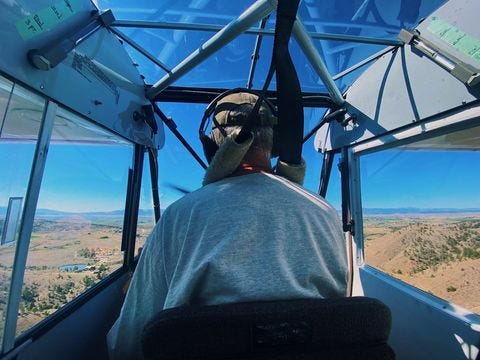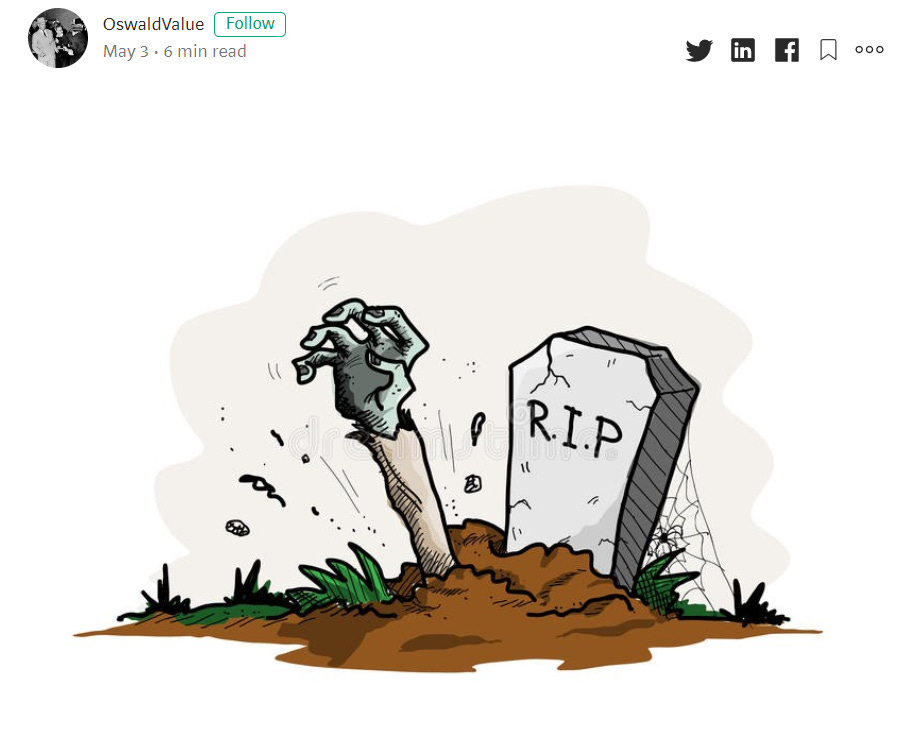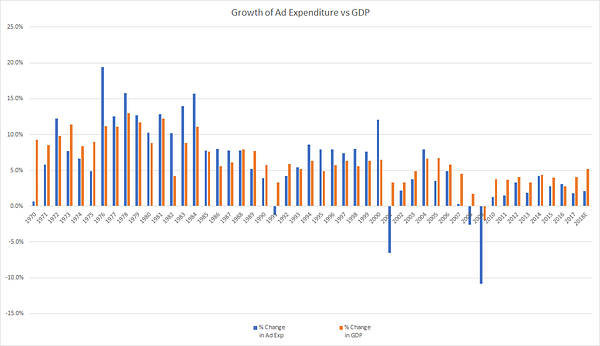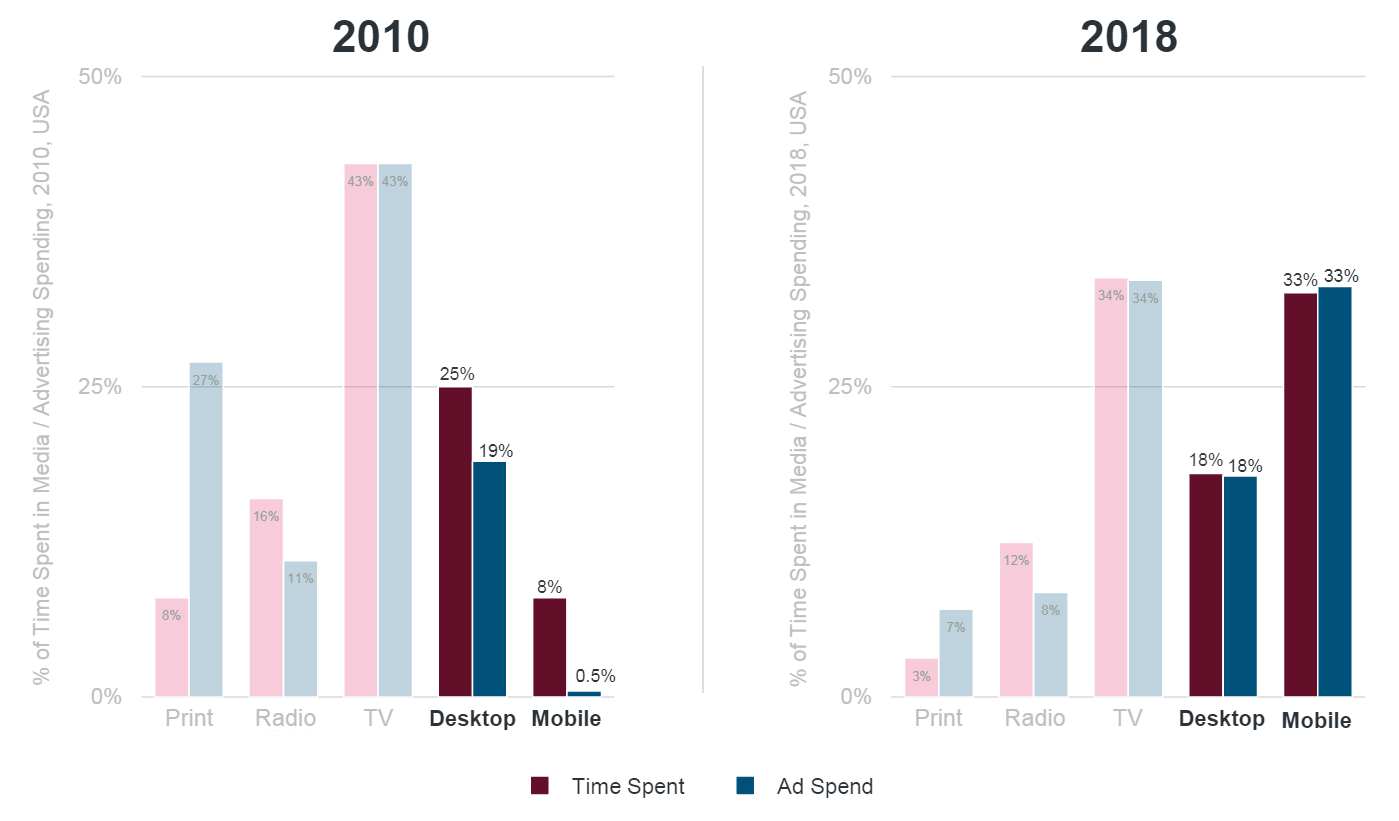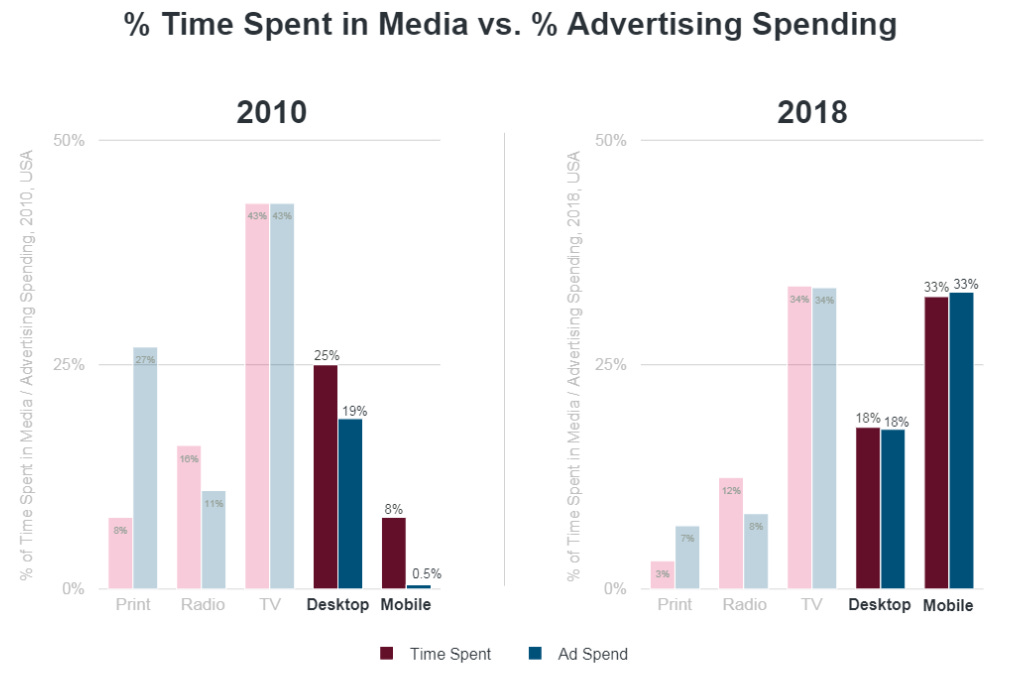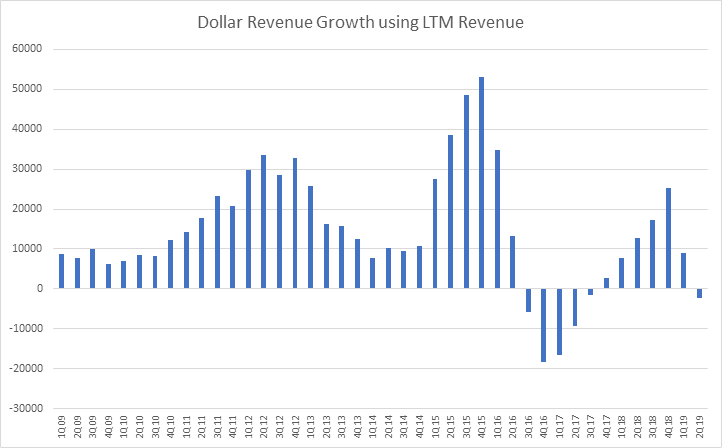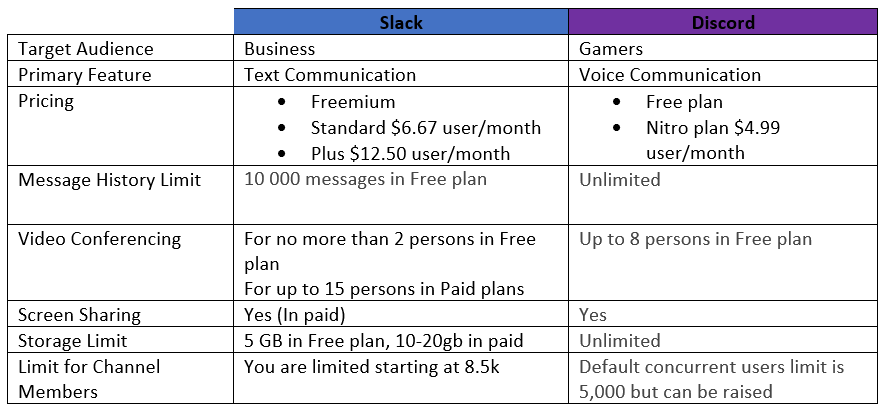You can subscribe here! There will be free and paid posts, but this is an outlet for all ideas, not-semiconductors.
It will be a much lower frequency posting platform, with a goal of ~1-2 posts a month that are paid: an idea and a follow-up. Additionally, I will write about business things I find interesting!
I think I have something to offer there. For example, in my last non-semiconductor post, Trend Watch #1, I listed COTY, IPAR, and THRN as ideas. THRN ended up being a bit of a bad one, but the ones I had way more money at risk, IPAR, and then eventually COTY, which I bought after I published, have done well.
The pricing will reflect the lower cadence, with a $50 monthly and a $300 annual. I will be religious about price raises. Every 50 subs will be a price raise. Since it’s a lower-frequency newsletter, I don’t want to encourage scalpers (subscribe for a month, read the ideas, and bail). Don’t worry; there will be a good amount of free content like Trend Watch and other random business adjacent analyses I am excited about. I look forward to writing more.
Anyways on to the newsletter. I have been itching to write about the reopening of China trade. Here’s a high level of some of the ideas I have in the space and what future newsletter content on the second substack will look like. This one is good, in my opinion.
Slight Update: I debated what to name the new substack for so long that I delayed this post. Everything still stands except for Rolls Royce's 20%+ price increase. The analysis still stands.
I have been a massive fan of the reopening trade. I don’t think I made it clear in the 2023 outlook piece, but by that point, I was convinced that the reopening in China was the highest conviction trade I could find, and its implications were clear to bet on.
In just a brief time since the market has validated the trade.
But it isn’t time to throw in the towel, as the fundamentals are just starting. I want to discuss the different ways to play the reopening, as I have a few ideas. This will be a shotgun release, and in no order, I will post some ideas I think are especially compelling.
Casinos in Macau (LVS, WYNN, MLCO)
I’m going to write the most about this
Widebodies in 2024 (RR.)
Duty-Free and Travel Retail Ideas (IPAR, EL)
Casinos in Macau
I think this is my preferred and favorite levered play to start. We even have a compelling case study: revenge betting after the United States reopening. The difference between the US and China is that China’s lockdown has been going on for longer, and the revenge spending will be much higher than the United States.
My favorite call this quarter has been LVS and LVMH, which confirmed that things are back to full capacity in Macau this Chinese New Year (CNY).
The problem we have right now is you can't get a seat in the games in our buildings. We're running 95%, 100% occupancy in those games. And the same applies to slot ETGs. The big question everyone's thinking about obviously is premium mass. - Robert Glen Goldstein, LVS CEO & Chairmen
If that's the case, in fact, it started in January. We have every reason to confident indeed optimistic on the Chinese market. In Macau, where the Chinese can now travel to the change is quite spectacular stores are full, it's really come back very strong pace. -Bernard Arnault, LVMH CEO & Chairmen
The problem is it’s hard to extrapolate, but I have a solid intuition that the Chinese reopening will be wild. For example, MGM said that the casino's strength lasted until February. I believe a full reopening is in order, and casinos in Macau are the first place we will see.
Our daily mass GGR was on par with the 2019 level for the month of January during Chinese New Year, far exceeded last year's Chinese New Year level, actually. And we are also encouraged to see that direct VIP segment in terms of rolling volume far exceeded 2019 level as well.
It is also very encouraging to see that January run rate extend into the first week of February so far. So all in all, we are very confident in a solid and sustainable recovery of Macau market this year and beyond.
- Zhi Qi Wang, MGM China Holdings Limited
The Chinese economy has been experiencing a period of inactivity, with investment serving as its primary driving force. At the same time, consumers in China have been given more freedom to make excessive spending decisions than they have had in quite some time. The Chinese government is not likely to be concerned with restricting luxury purchases, as they need any spending. In other words, gambling is on.
So What are the Casinos worth?
Let’s start with some assumptions. I fully believe that 2023 will be similar to 2019 levels of revenue for the casinos. The real question and the hard part of understanding is the margins.
First - the big overhang was that the Macau concessions would change their taxes on Casinos. The taxes stayed the same, which partially happened due to how horrible the current profitability of the companies was at the time.
Interestingly, the new concessions have a variable rate schedule, with the lowest rate seen in 2023. In 2021, LVS paid ~22 million a year for raw concession payments; in 2023, they will be paying ~12 million. This is a literal rounding error for LVS and other operators.
Still, amid the lean operations, slight tailwinds like lower tax concessions for foreigners and the shift from junkets (super high-end) to casino-sponsored VIP and premium mass could be huge tailwinds to the companies in the short term. Put differently; it seems that Macau should be able to see high cycle margins amidst revenue recovery to 2019 levels.
Revenue, however, has quite a long way to go.
I think the easiest way to try to value these things is by looking at previous cycle revenue highs and previous EBITDA margins ~28-38% and seeing where that nets you a price ~20% higher than today. That’s assuming a full reopening.
Where that gets you is an “easy” higher price of ~20% for both LVS and WYNN, and MLCO looks like it’s outrunning itself a bit.
But here’s the thing. Gaming came back huge in the US after the pandemic, and I think it will also come back for Macau. Marina Bay Sands (Singapore) has already hit a record high compared to 2019. That is an easy comp for what things should look like on the other side.
And what’s more, the revenue high is being done on lower visitation. When all is said and done, and visitation recovers to 2019 levels, revenue in Macau will be 20-30% higher. Additionally, while tables and slots are limited, more hotel rooms have been added to the properties in Macau since 2019.
In my opinion, we will likely see ~120% of 2019 levels for 2024. Adjusting for that, I believe shares could be much higher. Let’s assume 120% of 2019 levels and 100 bps higher EBITDA margins (buddy, that’s called conservatism) accounting for operating leverage.
That can underwrite ~50%+ higher valuations from here. I think that’s very attractive and, frankly, more likely than the base case of just pre-2019 normalization. I believe visitation should follow the trend that Marina Bay Sands is setting in Singapore and that by the end of the year, we should see new highs in Casino revenue and profitability in Macau. The shares look underpriced by at least 20-30% from here, especially LVS and WYNN.
Additionally, if you want to take way more risk, you can step into the local listings in Hong Kong. MGM China (2282:HK) is the best positioned from that perspective, as they took a meaningful share from the new allocations of gaming tables and slot machines.
Besides the fundamentals, I am mostly worried about the positioning and when to “quit” the trade. We have a deluge of good information, but the shares have already ripped. My “sell” decision starts whenever MTUM includes LVS and WYNN, which is not the case today. I’ll reassess the trade then.
Bus drivers to CEOs have been cooped up at home for years. It’s China’s huge reopening, and I think Casinos will be the place to be in the huge rush. There will be comparability issues in the future, but estimates haven’t even begun to move. This is a tremendous tactical trade.
Widebody, China, and Rolls Royce
Brief Update: This was written before the earnings post, and uhm, it went up almost 30% since! I still believe this company has incredible torque and is worth watching.
As someone who follows an industry with kinks in the supply additions and demand (semiconductors), one of the more exciting dynamics is that international widebodies have been shuttered over the last few years. One of the big reasons for this is China, which is now waking up with a vengeance. This could lead to a lagged supply curve, as supply is forced to catch up to demand over multiple years.
I have some ideas, but the one with the most torque is disgusting. Today I want to focus on the most exposed and worst-managed company of the lot; Rolls Royce.
But before I describe the opportunity, I have to give a context of this company. I remember the incorrect argument about afterbody sales at Rolls Royce in the 2017-2018 timeframe was that Rolls Royce would sell engines at a loss but recoup the upfront loss leader of the engine through aftermarket sales and service. It was even profiled in the book “Quality Investing.”
There was this legendary £1.2 billion in FCF by 2020 guide, which never came to fruition. This is from the 2018 Analyst day.
As you know, we have not given guidance on 2019. Our market consensus is just north of £700 million or so, I think. You know that we have guided to £450 million free cash flow for this year and are on a track to now go beyond the £1.2 billion in 2020
They got close to that number, and then COVID hit. Now Rolls Royce is losing almost a billion a year. However, I think a fresh look is warranted.
The reality is that right as FCF was supposed to inflect, a global pandemic lowered travel hit. The worst part is international travel, where Rolls Royce was best positioned, got hit the hardest.
In particular, they dominate widebody planes, and their fleet of engines is lower than average and skewed to international widebody travel. Well, what hurts for Rolls is that widebody travel didn’t happen for 2020-2021, and their engines are getting less used than expected. This is the worst case possible.
Shares have reflected how bad it’s been for Rolls in particular. And the company was in the midst of a turnaround. And amidst that issue, there is now yet another CEO. It’s been one of the most depressing and frustrating journeys for Rolls Royce of any public stock. Here’s a comparison to the other engine maker, Safran, to show how bombed-out Rolls is.
But if you squint, you can see the green shoots. Widebody is beaten down and is already starting to recover slightly. Here’s a graph of the percentage of 2019 flights from China.
I cannot express how much torque the Chinese reopening Rolls Royce has. They massively over-index China, and China has been a dead market for years. They are the clearest direct benefactor from an aero OEM perspective.
For this note’s focus on direct Chinese reopening plays, I think it’s clear that Rolls Royce has the worst financials, the most leverage, and the most torque for the Chinese reopening. But it’s also been among the worst-managed and the most painful stocks to own. Could it be different this time? Who knows.
Here’s a simple estimate of what they could earn based on a percentage of 2019 travel. Each 1%, according to management, is an incremental 30 million in FCF.
If we see 100% of 2019 levels in 2024, that is an 11x FCF multiple. That’s relatively cheap against Safran’s ~30x earnings.
Update: It’s more like 18x forward FCF on a ~800 million guide they gave, but I still believe that is conservative. Shares are still priced well! Compare that to Safran, which is 30x+ earnings. The run rate FCF could easily be north of 1 billion this year, in my opinion, making it still cheap! I believe the EV calculation didn’t change much, given cash didn’t burn!
Duty-Free Cosmetics
I mentioned briefly that duty-free is a great idea, and I have a few thoughts. First, there are the companies like DUFRY, which, literally as the name says, operates duty-free stores in airports. But I think there is a more nuanced idea set here.
LVMH, for example, has a meaningful Duty Free business, Estee Lauder historically over-indexed physical retail in China, and IPAR’s duty-free business used to be 15% of sales compared to 8% today. All of these ideas have reopening torque.
Duty-Free was once the fastest-growing channel before COVID, and was the place to be given the over-index of Chinese consumers. Now that trade is alive and well, and it’s time to review the duty-free channels that are most exposed.
The thought here is some of these businesses are secularly advantaged (skincare, fragrance) and have grown despite meaningful parts of their businesses being closed for years. Estee Lauder and Interparfum are two businesses I am most familiar with. I’ll start with IPAR since I mentioned them in my trends report.
Perfume, in particular, has always been a heavier retail segment. That makes sense since it’s hard to smell scents over the internet. But given that fragrances are having their moment despite global travel closures, I think this is a case of an advantaged business getting another tailwind at its back.
Take the case of IPAR; in 2019, its travel retail business accounted for 15% of revenue, and now it accounts for 8%. Total IPAR has grown 30% since It’s grown 50% since 2019, yet the travel retail business is still below. Since 2019, yet the entire travel retail business has shrunk in absolute terms.
Assuming that the retail travel channel returns to 2019 terms in absolute dollars, that’s another 2% tailwind in revenue. Assuming travel retail gets back to 15% in total revenue and it is genuinely incremental, that’s a 7% tailwind to revenue. Shares are expensive, but I like the strong companies with a distribution thesis for IPAR. Given that consensus estimates are +7% for 2023 revenue growth, this seems like a meaningful tailwind if estimates are too low.
IPAR trades at 30x ‘23 earnings, which is a bit rich. But i think revenue will come in meaningfully above consensus (say 10% versus 7%) and then EBIT should be meaningfully more incremental (say 15% eps versus 5% growth). That’s still an expensive 28x earnings, but I still strongly believe in fragrance stocks.
Now I want to talk about Estee Lauder, which has done surprisingly poorly in 2022. Estee Lauder is having some problems with its core brands, and despite growing much faster than competitors for years, given its skincare exposure, it hasn’t kept pace with larger peers like L’Oreal this year. I think this is an opportunity.
If I had to guess, part of the reason for this divergence is the retail travel segment. I read Estee, A Success Story, and one of the big standouts is that Estee Lauder was and always will be very levered to department store sales. It’s how Estee Lauder got her literal start and is a deep part of the company’s DNA.
Before the Pandemic, Estee Lauder’s sales were 26% of sales. Their largest customer for example, primarily sells products in China travel retail, accounting for 13% of sales in 2022. That’s quite a lever towards Chinese travel.
I have a more challenging time calculating what kind of torque EL has towards China retail traveling, but it’s material. Estee Lauder has a meaningful Chinese exposure that has been a headwind on sales for years. The multiple has gotten more expensive, but I think Estee looks the best positioned relative to peers, given their 25%+ travel retail exposure.
Buying L’Oreal could also be the answer, as they seem to always benefit from every trend and have a meaningful travel retail business. That could be an example of a strong business getting stronger with the addition of travel retail as a tailwind.
Parting Words
A few other beneficiaries are Luxury stocks and energy. Luxury companies simplistically should be bought on a percentage exposure to China, which include Swatch, Hermes, Burberry, Moncler, and Tods in that order.
On the energy front, I can’t pretend to have special insight into the supply and demand relationship there. I think energy will benefit, but I lack special insight.
Final note: I got mentioned to me that the EWQ (MSCI France) is a reopening ETF. Top holdings include LVMH, Kering, Safran, Airbus, L’Oreal, and hell; even Dufry is listed in France. A rough approximation of “reopening beta” as a percentage of ETF is 37-40% of the ETF is exposed directly to reopening themes.
That’s pretty good for an ETF! The exciting thing about the ETF is that while it is massively illiquid and hard to get calls (literally, I tried to get these), the IVOL is insanely low. If you can get it filled, this is a good beta. Or if you’re just a poor professional investor that cannot own individual stocks in their PA, EWQ is an exciting tool for the Chinese reopening.
I hope you found this post interesting. I want to write more about non-semiconductors, and I hope this is the right platform to do it. More information about what that will look like in the coming weeks - but I’m excited about this new chapter. I will still cover semiconductors, but I like ideas that make you money. And frankly, I have them less often than I’d like in semiconductors.
]]>I love semiconductors, but I love investing too, ya know? It’s a passion I started in high school, and I think anyone in public markets can relate to the passion and fun of working in public equities. Anyone who doesn’t love the craft probably works in Private Equity. Good riddance.
But before I was the semiconductor guy, I covered many companies, read many books, and thought long and hard about good investments and the craft of investing itself. As a guy who has read a lot of investing books, at some point, you realize that the real game in the market is mastering yourself. Everyone has a different hand to play, but you’ll have to master your psychology to play your best game. Some guys are absolute freaks at buying fear with conviction (thinking of my old PM), and some guys have a beautiful mind for numbers, but everyone is slightly different and has a different “thing.” Knowing and mastering yourself in public markets is how to be the best investor you can be.
In my journey of “knowing thyself,” I have learned a few things I am good at. Something I have always resonated with is a good trend, and I think I can spot good trends, small and large, and ride them well. Maybe that’s hubris, but I’m obsessed. To my close friends who know me - this is zero surprise. I wear Hokas, I was an early adopter of TikTok, and I constantly talk and think about trends in the world, big and small. I love and know that about myself.
However, If you don’t practice, you’re not going to improve or lose the muscle altogether. I don’t want to do that, and I want to commit to writing up a few trends I think are investable or interesting as I see them coming. This won’t be a regular series, but I’ll at least write once a quarter. We can laugh or celebrate my hit rate in the future. Without further adieu, here are a few of my favorite partially investable trends I see in public markets.
Trend #1 - Fragrances are on Fire
I couldn’t put my finger on it when I first noticed this trend. In the summer, I kept getting served fragrance TikTok content, and the legendary Jeremy Fragrance became a meme. But at some point, I had to admit, this was for real, and it had legs. My history of following the cosmetics market made me doubt, but I am here to say that Fragrances are in and will grow faster than the cosmetics market for the next few years.
For someone who has followed the luxury cosmetics industry for a long time, fragrances have been a bit of a dog compared to makeup, especially skincare. For some reason, that changed meaningfully in 2021, and now fragrances are the strongest part of cosmetic spending in the US and possibly globally. My favorite indication is a graph of the subreddit for r/fragrances. Somewhere in 2021, the chart took off.
The wild part is that 2021 was still in the COVID era, and going outside your house was novel. Maybe that’s where the desire to buy fragrance starts, but the real accelerant was Christmas when the Google trends truly broke out. Search almost any Let’s look at the meme fragrance, aka Dior Sauvage’s Google trends.
2021 was a real breakout year, but 2022 has been seasonally stronger than normal. I think 2022 will put a new high in the Google trends chart, and I don’t think this trend is close to stopping. For the most part, I believe this is a long-term trend reversion. Let me explain.
The pendulum for fragrance has been out of favor for a long time, with tepid organic growth and share losses the entire decade. This is the global cosmetic industry in 2021 by type. At ~10.7% of the €228 billion market, that’s ~€24.3 billion in 2021.
Compare this to 2014 - when fragrances comprised ~12.8% of the market. That means fragrances grew from ~€23 billion in 2014 to ~€24.3 billion in 2021, a pathetic CAGR of 1% over eight years! Fragrances have been growing slower than GDP and losing share within beauty spending.
I now think that pendulum has swung far enough, and fragrances are now cool again for whatever reason. If you look at recent results, fragrances are the fastest-growing segment in almost every major cosmetic company. Estee Lauder recent horrible organic results (-5% growth) were not caused by fragrances, which was their fastest-growing segment.
Fragrance sales rose an outstanding 18% organically and expanded in every region. Tom Ford Beauty, Jo Malone London, Le Labo, KILIAN PARIS and Editions de Parfums Frédéric Malle all contributed, driven by sought-after innovation and heroes as our luxury and artisanal portfolio evolves from strength to strength.
L’Oreal estimates the entire market grew ~16% YTD, and L’Oreal is ahead of the market by growing at 28%! That’s quite the divergence, and that growth rate is making skincare blush.
I'll start with fragrances. On fragrance, the market remains -- And we are, sorry, growing at plus 28% on a market that's plus 16%. I was quoting the number as 21%. So the market's at 16%, and we are plus 28%.
When the skincare “trend” started, it ended up being a huge source of sustained growth for almost half a decade, and I think that looking back, Fragrances could start that growth again. “Alpha” in beauty was buying the companies with the highest exposure to skin care. The ingredients for a repeat but for fragrances are there. It’s something that’s always existed but has only grown at a 1% CAGR for the last eight years and now has become important again. A catchup to the previous composition of fragrances would mean double-digit revenue growth for a few years.
Publically traded companies with strong exposure are (100% fragrance but mediocre brands) and (~50% exposure but a mediocre stock). These are huge opportunities, in my view, and fragrance as an end-market exposure should be considered a desirable trait in a cosmetic company for the first time in a long time.
Trend #2 Smoking is Cool Again
This one is hard to substantiate in the data because consumption volume is still declining, but I swear that Gen-Z loves nicotine (something we already know). Still, now they are rejecting modernity (vaping) and embracing tradition (cigarettes).
I don’t know where to begin, but I love this headline. I think it’s true.
There’s a confluence of events here. First, in 2021 tobacco sales rose. But second, I think cigarettes are another throwback trend. If we bring back the 1990s, people need to smoke a lot more per capita.
The problem is I do agree with the “it’s not hot to be addicted” energy. Currently, cigarettes are mostly an aesthetic choice, and it remains to be seen if Gen Z becomes power tobacco users like in the 1990s or just poseurs. For every GenZ user smoking a pack a month, a Gen X heavy user is quitting a pack-a-day habit. This trend might not have enough legs to make a difference in volume consumption. But it’s interesting to see the wind shift ever so slightly for the first time in decades.
I think the perception of smoking being cool again is so interesting. If there’s something that Trend Watch™ comes back to over and over, it’s that the pendulum of history always comes back. Smoking being cool again is something I never thought I’d see, but given how far the pendulum has swung against it, it makes sense.
A reminder for investors, and are the big cigarette companies. I still doubt if this can improve volumes for either.
Before I go, I want to part on a more zeitgeisty note. Another aspect other than the throwback trend, Gen Z has adopted nihilism in droves. Growing up with the internet, climate anxiety, and a global pandemic has driven home the point that nothing matters. Cigarettes are just another form of this nihilism.
I think the perfect rendition of smoking and nihilism is from the Chainsaw man manga, where one of the characters is convincing another character to smoke because their life expectancies are short anyways.
“It’s not like the smoking’s gonna kill you.”
Trend #3 - Andrew Huberman Podcast and Thorne
I want to leave my first Trend Watch™ on a much smaller trend but with a much stronger potential idea. The stock in question is a microcap, so it’s pretty hard to invest in it from any professional context.
The trend has two parts: the rise of the Huberman podcast to the top of the podcast game. Second, a supplement brand Huberman frequently mentions, Thorne. For those who don’t know, the Andrew Huberman podcast is run by Andrew Huberman, a tenured professor at Stanford. His podcast is excellent and often at the top of the charts globally for fitness and health.
I think the interesting thing is not just the podcast’s stratospheric rise to the top but a company and product he mentions frequently; Thorne. Thorne is a supplement brand and is often considered the gold quality standard by many (including Huberman himself).
Andrew Huberman will likely continue to dominate the top of the charts, and as more people are introduced to him, they will consider supplements. And wouldn’t you know it - Thorne is the brand he usually partners with. At the end of episodes, he mentions specific supplements and says you can buy them on Thorne at my referral link.
This has been a great thing for Thorne, whose sales have exploded in recent years from ~100 million in 2019 to 230m in 2021. The entire supplement market is much bigger (billions), and Thorne competes on the very high end of the market. But Thorne has been an interesting rise of a branded “Apple-like” supplement company in a world of brandless supplement companies. Reminder for professional investors, has a market cap of ~$230 million and is illiquid, so personal accounts only, folks.
The company has near-term problems, mostly scaling back sales and marketing for more profitable growth. It also only recently came out into public markets and is massively down year to date and since listing. All new issues and SPACs are this way year to date anyways.
But if you look closer, the numbers don’t look that bad. In fact, they look pretty solid. Revenue is growing ~25% this year. However, EBIT will shrink slightly because of higher sales and marketing. EPS is growing meaningfully, with a 2x over last year’s earnings, and likely continued meaningful growth in the future.
The company trades at ~13x 2022 earnings and 7x 2023 earnings (if you believe forward estimates), and Thorne has a 50% gross margin and positive net income. I believe the Huberman cycle still has legs, and Thorne’s premium positioning in a completely discretionary market is key. If the economy improves, they likely can accelerate revenue again. It’s an interesting company because it’s a luxury product in a purely discretionary market.
Anyways - I don’t know what a supplement brand should trade at. Probably a low multiple of earnings. But Thorne is a trend that I think has legs, as it’s perceived as a higher-quality product and is tied to the best health podcast in the game. The company has net cash, is growing, and has real unit economics but has missed near-term profit guides. That sounds like a long-term opportunity given to you by the market because of near-term problems. I like the stock.
I hope you enjoyed trend watch #1! These are hopefully some real investable ideas, and I love watching these trends over time. It’s something I’m good at, and I want to practice a bit more. Happy Holiday folks! The normal semiconductor content will be back soon.
Disclosures: The author has positions in and
]]>Update on Substack Status
First and foremost I want to tell you the good news. I will continue to be writing about semiconductors on Substack! I still am overwhelmed by the outpouring of support I’ve received and more than anything the hike got me stoked to get back to work. I have never felt more confident in writing a Substack and I’m feeling refreshed but still like some part of me is still on trail.
My plan, for now, is to offer a free post and start the paid substack again. So you should expect Substack to start billing you again in early October. Doing a lot of research to get the writing schedule back, so it’s a process. Also, I’m doing a relaunch so watch for big things coming!
Luckily for me, it looks like we have quite the schedule of events coming up.

My plan is to cover the analyst days and then slowly start doing some work on where we are in the cycle. I have a lot of subjects I want to write about and a few longer-term projects I’m excited to tell you about.
For now, I’m just trying to get readjusted to life, both literally and in the world of semiconductors. It’s a bit jarring to go back into the writing routine after walking 12 hours a day, so please forgive me if I’m a little rusty. I’ll get back there in no time. We have a lot of work to do.
But before all of that, I’d like to just share some consolidated thoughts about my adventure. It’s taken me a while to even get pen to paper, but writing about it has been very cathartic for me. Feel free to reach out to me and email me if you have any other questions. Talking about the experience is how I’m processing it.
Reflections from Trail
I thought it would be best to just answer a self-interview on topics that I have thought quite a bit about since I started on trail. The Continental Divide is a 3,100-mile-long trek from Mexico to Canada along the Continental Divide. It passes through some of the most remote areas of New Mexico, Colorado, Wyoming, and Montana. It took me 148 days.
Why Do You Hike?
One of the hardest questions to answer on trail when we met strangers was “Why do you even do it?” or some permutation of this question. To be honest with you, I don’t think I can answer it. My go-to short answer is “it’s an adventure,” but the longer answer gets so complicated that on further thought I don’t think I know why I hike.
I think I hiked the Continental Divide Trail (CDT) because I love challenges. I really like pushing myself, and the CDT was the hardest thing I could imagine. I think I hike because I love the outdoors and the simplicity. Life is really simple when you step down Maslow’s hierarchy of needs, and I found a lot more meaning and purpose to the day-to-day of hiking than I ever did while in the “real world.”
I think I hiked because I wanted a set of experiences that I get to keep till I die. But honestly, there were many moments where I would’ve disagreed with each of those statements. So I don’t really know. Sometimes I hated the challenges, sometimes I didn’t care about views, and sometimes there was nothing more in the world that I wanted than to be at home and comfortable. So to sum it up I still think “because it’s an adventure” is my favorite answer. Some questions remain unanswered.
What Was It Like?
Man, this is a hard thing to answer. I posted quite a few beautiful photos, and a few stories, but I hate to say it but photos don’t do it justice.
It’s hard to “bottle a feeling” and even just writing about the whole experience feels like a sham. I can’t just say “it was awesome” or “breathtaking” because those words don’t mean shit. There were moments of ecstasy, fear, joy, boredom, comradeship, beauty, and so on. But the thing I can tell you for certain is that each of those feelings came in the largest doses I’ve ever taken.
I feel like the extremity of emotions both high and low is unique to what a long trail (or thru-hike) has to offer. The trail offered insane situations over and over, and within hours I could go from the highest highs to the lowest lows and that’s central to the whole hike. I feel like I got to know myself better in those moments because I had never felt true moments of fear or joy in those proportions ever before. And in each moment I reacted in ways that frankly surprised me and taught me something about myself I didn’t know before.
But before I sound too sappy I want to have one friendly reminder to the reader: There’s a lot of hiking in thru-hiking. One of the people in my trail family (Dusty) started with a long-time friend who quit pretty quickly into the hike. I think he forgot the primary activity of a thru-hike, is well, HIKING. There are cool stories and such but they are just small punctuations between the reality of day-in, day-out hiking. That’s what we really did, we hiked 12 to 14 hours a day, day-in, day-out. All the other moments of serendipity came as but brief breaks between the primary directive, HIKING.
And man did we HIKE! Toward the end of my hike, I would split my day into quarters and hike whatever that amount would be, and then take a break. So let’s say I hiked 28 miles a day, that would mean four 7-mile blocks of hiking. At 3 mph that is ~2 hours and 20 minutes of hiking before a ~30-minute long break and then repeating that process three more times. Afterward, I would sleep and repeat it all again. Over and over and over for some 148 days punctuated by tons of days off. That is what hiking is like. I can’t begin to tell you how grueling yet wonderful it was.
What Were Some of Your Highest Highs?
This one is kind of easy to answer. The recipe for a high was pretty simple, a shared experience with friends, something beautiful, and serendipity. Some memorable ones were the day we had an easy day in Glacier with Skeebs, Dusty, and Kalidoscope (trail names), and the day walking around Old Faithful with Dusty.
Summiting mountains always were literal highs, like the time I did Mount Elbert with Toeby. I’m also really social so I think that day where we took a zero at Doc Campbell’s (didn’t hike forward) and stayed in the hot springs with Pogo, Jazzhands, MagicHat, NoNo, Season Pass, and Smudge. That was a really good moment and the real “beginning” of the whole adventure in my book.
What Were Some of Your Lowest Lows?
OH MAN. There were a lot of lows but I think the three that really stick out to me were:
The first encounter was with real snow and getting stuck in a tree well for 20 minutes and losing a shoe. A tweet at the time.
Deciding to keep hiking through sickness, which was painful and terrible. 3 days of hacking my lungs up while deliriously hiking up mountains was challenging. It would take me 5 hours to hike 10 miles and it hurt like hell.
Running from a wildfire or rather trying to outrun it and realizing that I was not going to win. A tweet at the time sums it up better than I can now
Finally, the basin, which was hot and hard given rusty trail legs. I took 4 days off the trail and pushed ~35 mile days multiple days in a row and it just hurt. The ugly landscape, intense heat, and lack of water contributed to the low.
I don’t really want to go further in detail, but I think I can make a very generalized statement about how all of my lows sucked. First, I was alone all three times. Second, it meaningfully shook my thoughts towards how I viewed myself. I realized each time I was weaker and less daring than I thought and they were all huge ego checks of varying sizes. Lastly, I think each time was kind of stupid and if a few more terrible things could’ve happened it would’ve been bad. Those kinds of experiences are true fear and shake you.
What Were The People Like?
Something you may have noticed is that I mentioned my highs were almost always shared with someone, and my lows were almost always alone. I think this is a natural segue to one of my favorite parts of trail, and that is the PEOPLE.
If you knew me on trail at all, I want to say thank you for every moment we shared together. I am sorry if I was grumpy sometimes (this is specifically for Dusty) but I promise there was not a person I didn’t like.
The people of the CDT are some of the greatest. I learned a lot from many of my friends, and I love the diversity and crazy backgrounds everyone came from. It ranged from a guy who was independently wealthy after selling his business, all the way to people who were professional vagabonds. And it didn’t matter one bit. The trail united us no matter where we came from or what we “did.” Hiking was our profession and good vibes were the most important thing.
First, I have to say that the whole “what do you do” question in America has to be the most overvalued statement ever. I truly could not care less about what you do but rather cared about how was it being around you and were you kind and enjoyable company. Your political views, your ethnicity (to be fair it skews extremely white), and where you’re from really did not matter. The real question was did I enjoy spending time with you? More often than not that’s a yes and then in my book, you are family.
One of the coolest things is the instant connection hikers have to each other. There is a secret language in the way you walk, the clothes you wear, and the way you smell. I felt like a meerkat sometimes. I would be talking to another hiker and then I would perk up and be like “yo that’s hiker” and we would both look over. We were always trying to say hi and meet a new hiker or just shoot the shit with friends.
I was always amazed at our ability to just gossip and yammer for hours. One time in particular I went to Glacier National Park to get permits at 5 am in the morning and Point3, Samwise, Carrot, and I talked for three hours laughing like madmen the entire time. The other people in line must have thought we lost it! What’s weirder yet was it was the first time I’d spent with them and it was like we knew each other for years.
Many times people would ask how long we’d been hiking together and I’d be like, “I met this person yesterday.” That connection was just so deep and so instant. They were the only ones in the world who truly could understand me. I miss that about thru-hiking. Your family was all around you, and the only cost of admission was hiking a long-ass distance.
What is a Trail Name?
This is one of my favorite things to talk about — trail names. A trail name is pretty much the fake name that all the other hikers call you by. You can name yourself but that’s kind of weird, so usually, your friends around you name you for some event or something that happened to you. I was named “Hobotoe” because I kept breaking my toe socks and my toes would stick out like, well, hobos’ toes.
You don’t just get named a shitty name and have to take it. It’s up to you to accept it, and in the beginning, I tried out a few names but nothing stuck. However, sometimes if everyone introduces you before you meet them, well that’s what people are going to call you. In Grants, New Mexico, Cloppy and McGoober introduced me as Hobotoe to everyone, and boom the name stuck.
I think something that doesn’t translate well is that trail names aren’t supposed to be cool names. They’re best when weird as hell. I mean Hobotoe isn’t exactly flattering, but I love it. It was a one-of-a-kind name and it has a cool cadence that I love when screamed. I can think of a few times where my friends just screamed “HO BO TOE” and that memory makes me smile.
The worst in my opinion was having a name that was really generic. A good example is anything bird-related. I met so many freaking bird names, like Freebird (cool guy), Strangebird (strange guy), LongBird (long guy?), etc., etc. Or if your name was something so generic you’d be asked “Hey, did you hike the Appalachian Trail in 2017?” and you’re like, no, that must be another guy called Cake.
This brings me to my next point. I truly believe that thru-hiking is a cult and the loss of our government names is an important part of that. Think about it — we change our names, spend time away from our loved ones, and endure insane shared hardship to create a little tribe that had a pretty hardcore “us versus them” mentality. I fucking loved it. Trail names are important, trail names are fun, and man I miss being called Hobotoe (preferably shouted).
Some trail names of the people I hiked with this summer, in no particular order:
Pogo, Cloppy, Mcgoober, Buckmild, Toeby, Dusty, Scoutmaster Keebs a.k.a. Skeebs, Catwater, Oldtimer, Davinci, Snowcone, Snowballs, Fire Hazard, Spidermonkey, Gravity, Kaleidoscope, NoNo, Pax, Chillzen, Riddles, Dog Gone, Jazzhands, Salty, Loverboi, MagicHat, Melon, Pantry, PDF, Bison, WizardSpoon, Poly, Riverdance, Cake (x2), SoGood, Topo, 2Taps, Bullet, Spamcake, Cheeto Jackson, Spench, Peach Fuzz, Lizard, Paddles, Little Sprout, Big Sprout, Tumbleweed, Crispy, LongBird, Blitz, Money, Nude Beach, Horse, Road Runner, Carrot, Point3, Samwise, Thirteen, Shepard, Fried Green Tomatoes, The Brown Streak, Bellows, Beta, Farmhouse, Prince, Crunch, IBTAT, Tapeworm, Bud, Tex, Oldhead, Stubbs, Frisbee, Trigger, Savage, Machine, Mooch, Wild Turkey, Sugar Mama, Animal, Moose, Sunshine, Teton, and probably a few more that I’m missing.
I miss ya’ll.
Did You Hitchhike? What is Trail Magic?
Hitchhiking was pretty crucial to hiking. Whenever you poked out of the wilderness after a three-to-seven-day stretch you would have to resupply, and the trail spits you out oftentimes in the middle of nowhere. In New Mexico, we walked into the towns, but in Colorado onwards, we would have to hitch.
I really enjoyed hitchhiking.
It would be the logical beginning and end of each section of trail, so whenever I put the thumb up it was like a chapter was closing. I met some really cool people as well. Some of them were just really kind strangers, some gave me the hives (looking at you Lincoln hitch). It was all part of the experience.
Hitchhiking obviously has a bit of a negative connotation these days. More aligned with serial killers than with thru-hiking. My overwhelming experience was super positive and I think you have to believe in the goodness of people. Because despite whatever you’ve been told, people are way more often good than not. This is the obvious time to talk about TRAIL MAGIC.
Trail Magic is just the term that is given to any external help that is given to you on trail. A cooler that said “hikers” with some Dr. Pepper (sugar crack) was a blessing. A meal that is given to you by another camper, also a blessing. When you have so little, each and every little act of kindness is akin to magic, hence “Trail Magic.” The people who perform Trail Magic are “Angels” or Trail Angels.
It’s really sometimes just as easy as asking. I met this guy Spidermonkey who just asked relentlessly and he got a lot in return. I really think that the only thing stopping humans from helping each other is just a little friendly reminder.
One of my favorite trail stories is the Tacklebox Boys on their roadwalk around the Morgan Creek Fire managed to get 40-something beers, multiple pizzas, and put up in a cabin for free! Just by holding up a sign that said “Beer?” People really just needed a gentle nudge, because the kindness we give each other is priceless.
I had so many wonderful little interactions with people that I don’t know where to start. But I have to say, sometimes you really hit the jackpot. People are so kind and the trail will teach you this lesson with so much force that it will change how you view others forever. Take it from some friends of mine, who literally got flown in a prop plane by trail angels who let five stinky hikers stay at their house. That is magic, and that man is an angel.
Would You Do It Again?
Hell yes. But I need to do some real-world stuff for a while. It’s going to be a bit before I’m out on a long trail again. So don’t worry, Substack readers, it’s good to be back to semiconductor investing for now!
]]>Week of the Living Dead: a post-mortem on the Adpocalpyse
Worth a read and I’m going to call this my official stance/response.
I’ll be back soon! Cheers, and stay healthy ya’ll.
In my extremely noisy twitter feed over the last few weeks, there is a single thread that I keep coming back to. Advertising and digital advertising especially would be different this time than last. And as far as I’ve seen it, it would suffer a very significant contraction for some common sense reasons. The stocks so far seem to think otherwise, and I just wanted to start with a very simple build-up and then comparison to sell-side numbers. While some revenue cuts have come, large-cap digital advertising to me seems to be living in fantasy land. The companies themselves have ample cash, extremely durable platforms, and are going to survive. We just need to check some expectations at the door. Let me walk you through what I am thinking;
The Inescapable: Advertising is Cyclical
I guess the first debate is the secular versus the cyclical aspect of digital advertising. Many could point to the 08, and the ability of google to grow during that downturn. I would point to penetration. Digital advertising is now the largest segment of advertising and will suffer if advertising suffers broadly. I believe they will do relatively better than traditional TV, but COVID comes for all.
If the historical relationship of cyclicality holds still, there is no way you can justify positive advertising while GDP growth estimates for Q2 / FY2020 with anything positive in terms of revenue growth out of digital advertising giants.
Digital Advertising is Liquid Opex Cuts
Unlike committed spend to now canceled events, programmatic (the preferred way to buy digital ads) is liquid. Anything that can be cut will be cut, and what’s liquid is a great place to start.
A quick reminder, programmatic is the term used for buying advertisements on demand. Each time your screen loads with Facebook ads, Facebook auctions off your eyeball’s value to an advertiser. The advertiser bids on the ad inventory based on how much it is worth it to them knowing information about you provided either from Facebook targeting or first-party data you bring to the platform. These bids are near real-time. What’s also great is if you are now not able to sell your product (travel/retail), or your product is discretionary and your customer is uncertain or affected (auto/discretionary purchases), you can turn that hose off.
Now imagine you are one of the many companies impacted by COVID. Your revenue is down a ton, you are forced to do layoffs, do you think you protect a super liquid discretionary opex line item before everything else? If you’re a test budget or further down the chain of unproven advertising inventory, or just not meeting ROAS, turn it off. It’s that simple. Below is a simple graphic of what is the first and last to go from right to left (sorry).

This graphic is directional, each platform varies in its usage
Note the inverse side of this as well, If the economy has a quicker than expected recovery the ad dollars can be quickly turned on. If there was a very quick recovery, ad digital ad spending would be quickly turned back on in ways that ad commitments to large TV-based events couldn’t be. But that depends on what the shape of the recovery will be like.
Usage is up, Revenue is not up
There are a variety of sources that point to it, but clearly, usage on social media and many digital channels are up. I’m going to use the Verizon report as my base case, that broadly web and impressions are up ~25%.
So we can guess that inventory/impressions are up 25% while assuming the same ad load, it means you will be served more ads. You may even click through more, but if you do not make the final purchase, advertisers will be less likely to pay for the lower conversion. Importantly consumers must have the willingness or ability to purchase the items. There is a marginal return on seeing more ads in your feed, and it makes sense that CPM rates would fall as inventory (supply) raises and demand (purchase intent) falls.
If I lost you in the AdTech world, all you need to take away is there are massive negative marginal return rates on ads in your feed. Being bombarded by more ads does not mean you will make more purchases, and even with higher usage, there is a world where we have more impressions but less spending.
I like this succinct quote from former AOL CEO which sums it up nicely
“For the first time in history, you’re probably going to have the highest point of media usage in the history of the United States and the lowest point of advertising in the U.S.”
There’s Evidence We’re Already There
This is going to be the anecdata section, and while there is data everywhere it’s hard to have a representative sample size of a 200 billion dollar market. I think the key ones that I feel comfortable relying on are the IAB survey, which is a meta survey and probably the largest sample size we have. Some high-level survey results are posted below. I encourage you to click through.
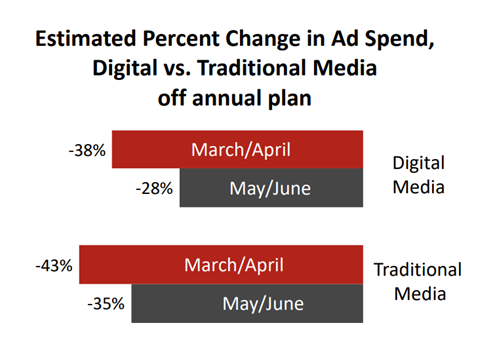
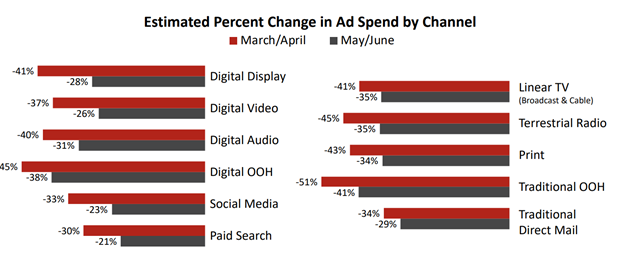
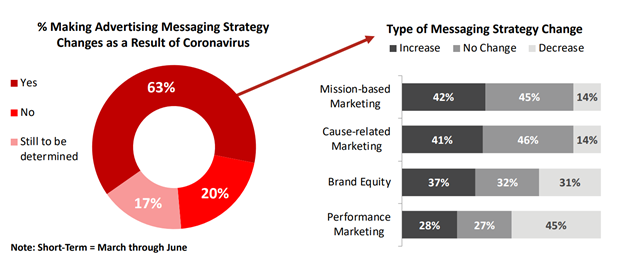
A reminder that the math is the advertising cuts assumed in the IAB survey is the contraction from previous spend estimates, which I’ll use a +15% YoY napkin math number for. Assuming this is indicative of total advertising spend, and that ad spend in digital was +15% YoY before, this would broadly mean a ~29% contraction in March/April, and a ~17% contraction in May/June. Assuming monthly ad spend is equally weighted, this is a -20% ad spend for digital in Q2.
I am going to post some more sample sizes that are “making the rounds” and some things I found interesting.
Other Links & Quick Summaries
The Online Ad Revenue Index
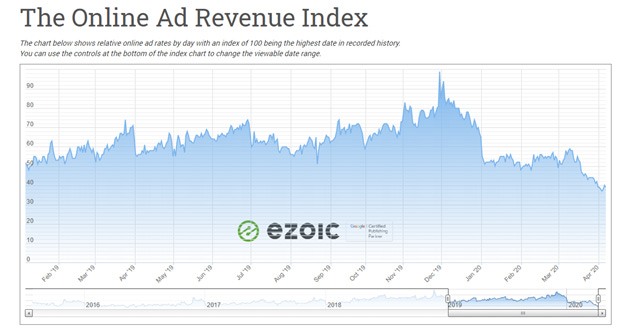
This is a rough proxy for publishers on display ad rates over a supposedly large sample size over the ad sense network. This is a good proxy for the “Google Network Member” line item on Google’s income statement. It’s down ~40% YoY.
Socialfulcrum on what they are seeing on Facebook:
CPM down ~45%
CTR unchanged
CPC down ~45%
Onsite Conversion down 53%
Overall, Cost of Customer Acquisition up 28%
Within Retail and what they are seeing in Google / Facebook
Omnichannel Facebook spend is up, while Google spend is down
Pureplay Ecommerce is down ~30%, with Google down more than Facebook
Fashion is down with Google spend down more than Facebook
Essentials spend is up, with Google up more than Facebook
Luxury spending is down, with Google and Facebook similar spend
They manage ~$500m in spending
Tinuti on what they are seeing
Impressions are up massively, with 60-80% during the second half of March
CPMs are down, conversion is down
For them still growing Y/Y for Facebook / Instagram
Amazon growing teens spend
Google Spend declines Y/Y as conversion falls
Adexchanger Round up on impacts
Bustle, G/O media, Maven Media, and others are laying off staff
40% decline in programmatic CPMs
Adthrive – Less bad than expected on Q2 Day 1
Twitter Update
While the near-term financial impact of this pandemic is rapidly evolving and difficult to measure, based on current visibility, the company expects Q1 revenue to be down slightly on a year-over-year basis. Twitter also expects to incur a GAAP operating loss, as reduced expenses resulting from COVID-19 disruption are unlikely to fully offset the revenue impact of the pandemic in Q1.
Facebook Update
Much of the increased traffic is happening on our messaging services, but we’ve also seen more people using our feed and stories products to get updates from their family and friends. At the same time, our business is being adversely affected like so many others around the world. We don’t monetize many of the services where we’re seeing increased engagement, and we’ve seen a weakening in our ads business in countries taking aggressive actions to reduce the spread of COVID-19.
Pinterest Update
“The near-term financial impact of this pandemic is rapidly evolving and difficult to measure and quantify. First-quarter revenue performance was consistent with our expectations through the middle of March, when we began to see a sharp deceleration. Fortunately, despite weakness across nearly the entire advertising market, our exposure to some of the most affected segments like travel, automotive, and restaurants has not been significant"
To be fair to Pinterest, I’m impressed with their relative strength.
Amazon, Walmart Suspending Marketing Deals
Amazon and Walmart have temporarily suspended commerce marketing deals with digital media firms such as BuzzFeed, two people familiar with the situation said.
What’s more interesting are these companies are thriving during COVID, which creates an interesting situation. Some companies have such strong demand pulls there is no reason to advertise for demand creation. If you’re forced to buy something online, you’re going to be searching on Amazon.com, not on Google. Other smaller eCommerce companies such as Zooplus have paused spending as well.
Booking and Expedia Alone Can Account for Meaningful Decline
The travel giants account for single digits percentage of revenue for Google alone, and many other large customers are likely not spending anything during this period as well.
Summary: There are a lot of small sample size bets and updates from companies that seem to support there is a significant contraction in ad spend in late Q1 / Q2. While the recovery debate rages on if it is a V shape or a U shape, it’s clear that there is a material impact on revenue. Let’s lastly compare to sell-side estimates.
Sell-Side Consensus and Reconciling the numbers
So this brings everything to this, how the hell can you possible reconcile everything above with what is below? How can any AdTech platform post 1) flat Q2 numbers 2) positive FY20 numbers? I believe bottom-up estimates are wrong.

This is based on Bloomberg consensus right now as of 4/8/2020. Ty @son2dweeb for help on this.
I have a hard time believing these numbers. It could be that buy-side is already ahead of the cuts but with this much uncertainty, it’s anybody’s guess. I think that in the coming days this debate will be solved into earnings, and I guess is that the above numbers are exceedingly optimistic. I think we have quite a gap in expectations here, and either everything I’ve highlighted above is wrong, or we need to be checking our expectations right now.
My guess: Advertising is broadly down 20% in Q2, with social outperforming search as of the end of March. As we continue and more discretionary purchases wane, social will become more in line with the average digital advertising cuts.
While the above IAB estimates look drastic, I would guess smaller brands and SMBs are impacted even worse. Facebook and Google are materially exposed to both. I believe ad spending intent will slowly pick up as we recover, not quite following for the first quarter or two, but eventually outpace the economy next year.
Time and the shape of the recovery will tell if this becomes true or not. I hope everyone is well in this uncertain time. If you found this post helpful, liking or sharing it is appreciated!
]]>Source: Mary Meeker Internet Trends 2019
Why? Well with every new form of engagement, there is a testing period of how sustainable it is, how to advertise, what’s the medium’s lasting power, and then slowly advertisers flood in. You can argue whether one cohort or medium is more valuable than another or other semantics, but I think that broadly the truism stands. Ad spending has to follow the oxygen that is attention, and without attention money never follows.
Why do I mention this advertising truism? Well I think with this framework in mind we can do some real “analysis” on influencers, social trends and the internet.
The Changing Fame of the Internet
But first I have to talk about the changing nature of fame aka eyeballs or attention. The internet has made it so that anyone, at any time, doing anything, can become famous. Saved two kids from an incoming car crash on cctv? Boom r/dadreflexes welcomes you as their god. Are you an Arizona wildcats fan and said the word stop to a cameraman? She lives on in eternity at r/TheStopGirl. These micro moments have high relevance and low durability, but they do persist. And for the people who know the meme you’re referencing, that person or context can be a big deal.
Compare that to the previous monoculture – largely defined by TV, Movies, and Radio. All media that have multiple gatekeepers and escalators where the ultimate metric of success was reach. That is, get the approved content to the top of various content platforms and boom you’re famous. I would argue that the internet is the opposite, its all about finding the perfect fit for your perfect community, and if you found that fit your community will love you and then disperse the content outwards onto the platforms they take part in. I believe that on the internet, the most important metric of success is relevance to your core in-group. One is top down, the other is bottoms up.
In a bottoms up view of the world, we now have microcelebrity, which in the past was a completely useless currency. How that changes going forward, well that’s the change in internet fortune.
The Changing Fortune of the Internet
As late as 2013-2015 I would argue that the path to fortune from fame on the internet is just an accelerated version of how monoculture / the current system surfaces talent. Let’s take Shawn Mendes, a breakout cover artist on the now dead Vine. After enough circulation he was discovered, signed, made an album and hit the top of the charts. That is a co-opting of how things used to be.
Meanwhile we have George Miller, aka Joji, aka filthyfrank. Miller’s past lies in his dark humor YouTube channel, filthyfrank. He began focusing on his new music project Joji in 2017, starting with launching songs on the 88rising YouTube channel. His niche but hardcore following has slowly followed him and promoted him, and in 2018 he’s started to become relevant in larger non-subculture context.
I think this is the core concept of “1000 true fans” at its best – and in the future the path to fortune on the internet is being armed by the likes of Shopify, Patreon, YouTube and others. The true direct to consumer revolution is not in commodity mattresses, it is the direct storytelling and connection between fans and idols. The changing fortune of the internet is quicker feedback loops between the fame and the fortune, armed by platforms online that makes this more sustainable. The future couldn’t be brighter in my estimation for these platforms.
Fame and Fortune Case Study: Jeffree Star
So now that we have discussed Fame and Fortune, I want to say that I think of these as leading and lagging. Fame usually is leading, with a large group of fans supporting someone but often after the initial burst to fame they don’t really know how to monetize this correctly. Through human ingenuity they will find a way to monetize. For certain people they will have their breakout viral moment, several “almost as high highs”, and then their time at peak relevance is over.
Meanwhile fortune is pretty much selling out. We all see it. Artists are accused as “selling out” – and for creators that have one hit wonders and cannot successfully reinvent themselves, the monetary gain is always after the fame. And like their fame it tends to fade slowly over time. A sign of a weak and dying creator is more sponsorships, less content, rehashing old content and throwbacks. Creating a podcast where you leverage your current following to get famous people to come on, and then use social proof to keep it afloat is a sign (I’m looking at you h3h3productions). While every creator must adapt, when its outside of their original core competency, its “over”.
Anyways besides me espousing let’s play trend spotting! You have to do a bit of work and I recommend reading my piece on S-Curves to help understand better, but I hope that I can show you peak relevance and “fame” clearly leads fortune, and you can use this pattern to find emerging trends consistently.
And the best case study I can find of this so far is Jeffree Star and his breakout 2018-2019. While hopefully you know of the staggering Dawson x Star conspiracy sale on November 1st 2019, what’s crazy is that Star’s true breakout moment was over a year in advance. Shane Dawson’s 40-minute-long documentary on August 1st 2018 and follow-up series amassed over ~150 million views, and you can see the step jump in subscribers below. That is “fame” and it was obvious for anyone following along on YouTube.

The Fortune moment was over a year later, and while there was a burst of activity around that time frame, it looks like normal weeks for both Jeffree Star in terms of weekly subscribers added and video views. Imagine what it would of looked like if they could of done it at the peak.
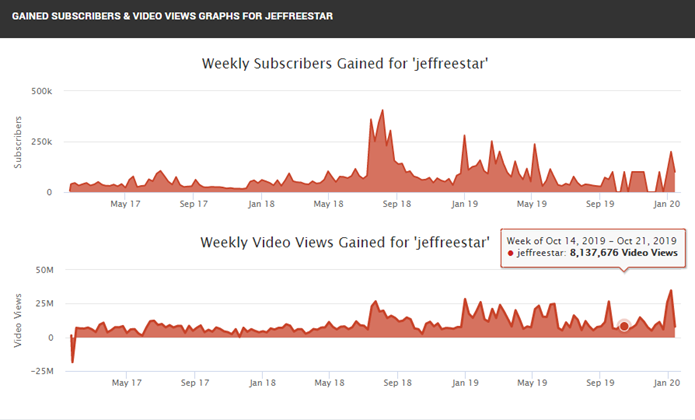
Meanwhile Shopify crashed that day with over 60 million dollars of hardware set aside for the launch, and the entire collection sold out in minutes. According to @web Jeffree Star and Shane Dawson did 54 million dollars of sales in 6 minutes. That’s quite the internet fortune if you ask me.
The most interesting thing to me is that it was clear that something would happen after that internet moment of fame for Jeffree Star. That kind of fame as a leading indicator always ends up as something big. With the ability to sell merch (or makeup in this case) as the best way to monetize it, it’s no surprise that it ended up as such a big fortune. That time period between peak fame and peak fortune? I call that the gap.
The Gap: The Most Important Trend Watching Window
The gap is pretty much the time from the peak internet relevance to peak monetization. It’s lucky of us to have such a clear and distinct case study with Jeffree Star, but I believe that this still broadly applies.

It’s simple. Find an emerging force in culture, watch it closely figure out what the second order effects are later. For example, one second order impact is that Jeffree Star approved of a putty primer by ELF, and that new launch probably helped ELF beat 4Q18/1Q19 revenue expectations. Just watching his fame and figuring out the second order effects later is the job of the watcher. There are many more examples but that’s your job to figure / find them out. 😊
The sad thing is this gap is going to close faster, and the subsequent trendspotting window will be quicker. With contract manufacturing, Shopify, and direct response marketing, the tools have never been quicker to capitalize on your moment of fame. Luckily for us in the internet age we are going to see more and more of online culture trickle up to the mainstream.
Maybe rephrasing Soros “When I see bubbles, I rush in to buy”, is now “When I see a trend, I rush in to vibe”. What internet attention blackholes am I watching right now? Tiktok 👀
]]>First off — I want to say that this post is definitely inspired, as all things are online, by the stuff I’ve read before — and 2 pieces in particular come to mind. First this piece on s-curves at lesswrong.com by mr-hire and second this piece by Eugene Wei.
Also while I’m at it, disclaimer time: nothing is investment advice, nor do I have any idea what I’m doing, this is an anon blog and you should take everything accordingly for someone who won’t put the skin in the game of my real name. I truly hope you’re beyond taking advice from strangers on the internet.
So, if you haven’t figured it out by now, but S-Curves are notoriously hard to predict. Maybe its non-linear thinking, or the human’s inability to understand exponential growth, or hyperbolic discounting, or whatever. All I know is that it’s clear that S-curves are hard to predict.
I was raised on Valuation by Damodaran, and if I recall correctly you’re supposed to decelerate growth to the industry growth rate in the end terminal period as a kind of best practice in a typical model. You see it all the time in models of others, consensus revenue estimates, etc. A kind of double discounting on the growth rate beyond your discount rate itself. And for the most part this makes sense in linear growth companies, but S-curves… are well s-curves! Looking at the base rate book and you’ll see that the previous revenue deceleration assumption is right on average, but obviously s-curves have this weird power that when they inflect over a certain adoption percentage they accelerate — or stay flat as a percentage of revenue. Imagine with a straight face suggesting that a company will accelerate to your boss, when all you’ve ever been taught is mean reversion to the dust. Pretty hard if you ask me!
This is from the Less Wrong piece
This is where dollar revenue growth really shines from an analysis perspective. Now be forewarned, there are no silver bullets, just another framing tool and constant pruning of the bookends of your expectations. And from a high-level dollar revenue is pretty much stolen from this chart, except graphing the dollar revenue to match what you see here.
Also from the less wrong piece
So let’s see it in action with one of the most famous S-Curves ever, Apple.
Apple — Over the S-Curve Hill
The second “hill” was the larger format size, an expansion of their TAM.
Not quite as clean as the graphic huh? And not to mention we had some significant decelerations or even dollar shrinkage for Apple multiple times. If you think about the historic stock prices for Apple and stock narrative scares, this really helps put the multiple contract and deceleration fears in context (below).
The multiples are just contractions due to fear of deceleration. Well I can hear you say “duh mule — you can just tell that by a lowering of sales growth percentage — this is the dumbest analysis ever and pretty much showcases your lack of understanding for calculus.” — but just wait! I think this helps give nuance to what’s so different about the 2016 bear case on Apple than the 2013 bear case on Apple.
In 2013 the company was still growing and decelerating, meaning its over the hill but I would feel much more comfortable with that chart than the 2016 deceleration, just because it was still positive. Meanwhile in 2016 I can feel very confident we are over the S-curve hill for iPhones, and there is no way else to cut it. We may see dollar revenue go positive or negative in the future, but that really is a function of the replacement cycle.
And I think that’s okay! The current bull case is now predicated on Apple services, another huge growth story in it’s own right.
(There’s a 1 time charge of 640 in 4Q17 — but the dollar revenue deceleration is something to be a bit wary of.)
And while this is all very transparent in the ever-high-profile Apple, you can make inferences similar to this but on much less covered companies using Dollar revenue curves. Also feel free to do calculus on something as noisy as quarterly results — this is just how I do things and think its much easier to understand.
But likely the problem on this analysis here is that iPhone now have hardware cycles, as they have become durable products. So where this really seems to be the best framework is for companies with consistent annual revenue and no replacement cycles growing through secular s-curve adoption… which reluctantly brings me to an analysis on everyone’s favorite topic as of late, Software as a Service.
I think where this tool is best used is probably in consumable viral products, and recurring revenue subscriptions. The product has to be bought each year with a short life span, so maybe Spin Master(TOY:CN) is probably a good example for viral product adoption cycles — and the dollar revenue chart sure tells a story. Reminder Spin Master made the viral hit Hatchimals.
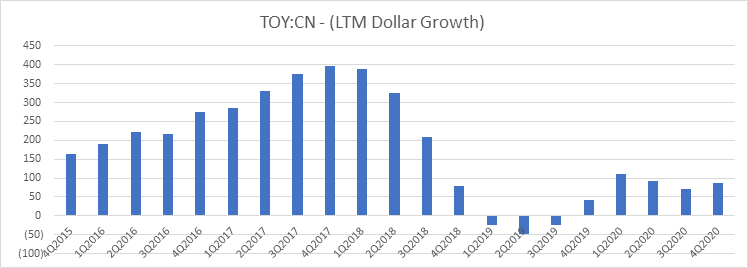
Talk about a vicious deceleration — Forward numbers are IEBS consensus
Salesforce.com and S-Curves
So, let’s change the subject to the grand-daddiest of all SaaS companies — Salesforce.com. I think the dollar based revenue assumption really shines best here. First let’s look at overall dollar revenue. Disclosure again: the model isn’t mine I am shamelessly stealing from a sell-side model here — and I don’t really know CRM past the cursory glance. The point of this post will be to look at a company I know almost nothing about, and see if the dollar revenue growth tells a story.
Let’s first take a look at total revenue dollar growth

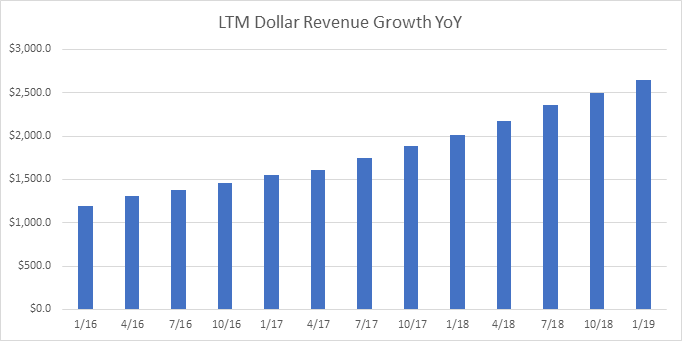
Up and to the right eh? What does this say if we refer to that S-Curve chart?

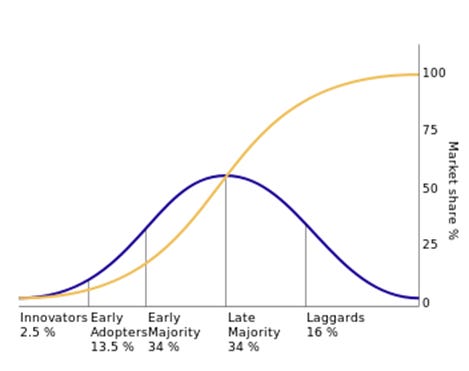
Oh wow — they aren’t even over the hill!? Now I don’t know if this is really true — but I think that by segment level tells another more interesting story. Let’s look at dollar revenue by segment.

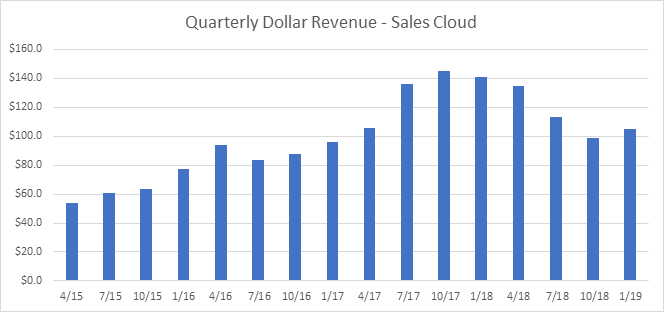

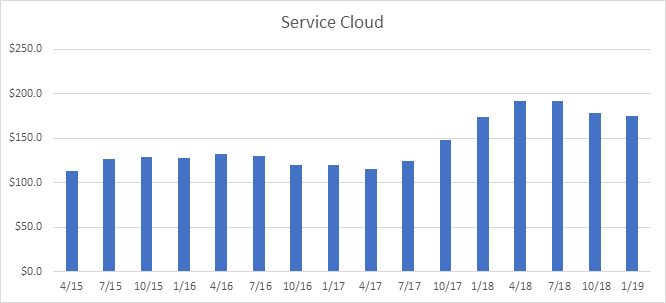

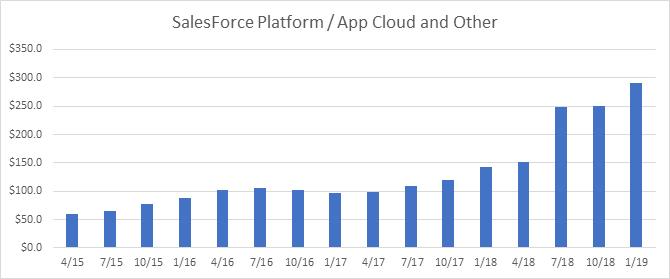

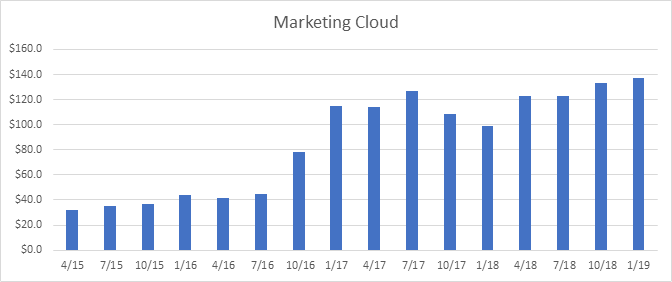
So now things really change in perspective. We can make some broad generalizations that may or may not be right, just based on the numbers without much context.
Some helpful context is that Salesforce acquired Mulesoft in 2018 and consolidated it with Sales force platform (App cloud), and they acquired Datorama in late 2018 and consolidated it with marketing, and they also acquired Demandware in early 2017 and I presume consolidated it in marketing cloud.
1) the core sales cloud is past it’s prime, there is no doubt. Revenue will still grow, but your estimates should complete that dollar revenue hump to some reasonable extent, unless you believe they can reaccelerate with something new. I find in reality the late laggards are much slower than the early adopters, and the right side of the curve is right skew.
2) Meanwhile Service cloud’s dollar revenue growth shows a business that seems either past its core s-curve adoption, a series of acquisitions, or had hit some invisible asymptote and moved past it as of late. There’s a lot to unpack there — this warrants a further look.
3) App cloud looks like an acquisition (significant jump) — if you can unpack the revenue from acquisition you can confirm / disconfirm their revenue growth expansion ability.
4) Marketing cloud looks like 2 acquisitions — and a period in between the acquisition with lower dollar growth — I would truly doubt the ability to grow in a positive dollar way into the future, expecting deceleration seems warranted.
I don’t know if any of those opinions are right, but I do think that the dollar revenue framework does give a lot more nuance than the chart below.

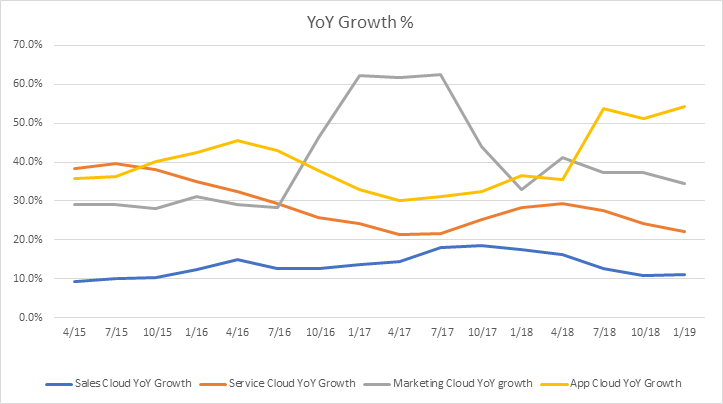
Anyways — I hope that helps prove out how to think about dollar revenue growth, and its use to help better frame the revenue perspective going forward. And let’s kind of flush it out for forward quarterly revenue expectations

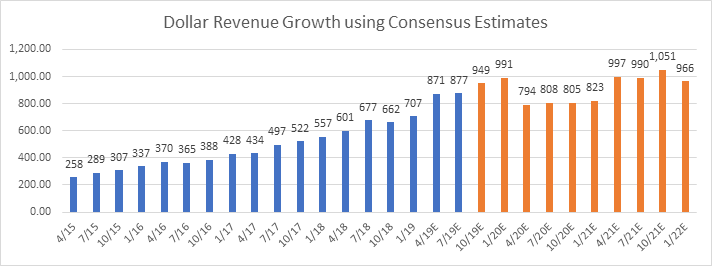
Yeah I have no idea what to tell you about that chart — other than 2020 numbers are really freaking weird and seem wrong. I would guess because it’s a hard-coded step down to ~20% revenue growth, but in the context of dollar revenue this doesn’t jive with reality. The unfortunate reality is that consensus estimates past the quarters for the rest of the year are kind of numbers they throw at the wall, and the most accurate and thought about numbers in consensus is the rest of the year based on guidance. Oh well.
Another Benefit of Dollar Revenue Analyses — Dollar Market Share
Like the rest of the investment community, I too have been shocked by the absolute staggering growth of Amazon Web Services & public cloud in general. I often hear arguments like “well Azure is growing much faster, they will catch-up” and logically a company growing 80%+ YoY makes it seem like the lead isn’t that far away, but this is where Dollar Revenue Share comes into play as well as a better framing tool.
Disclaimer: Most of the data is from Goldman estimates, I know they are precisely wrong, but probably generally correct.
First their Dollar Revenue Growth Charts — GCP sadly is not even close to broken out enough, and Azure’s revenue estimate is dubious to say the least, but I’m piggybacking on the analysts at Goldman’s work, which I think is a fair estimate.

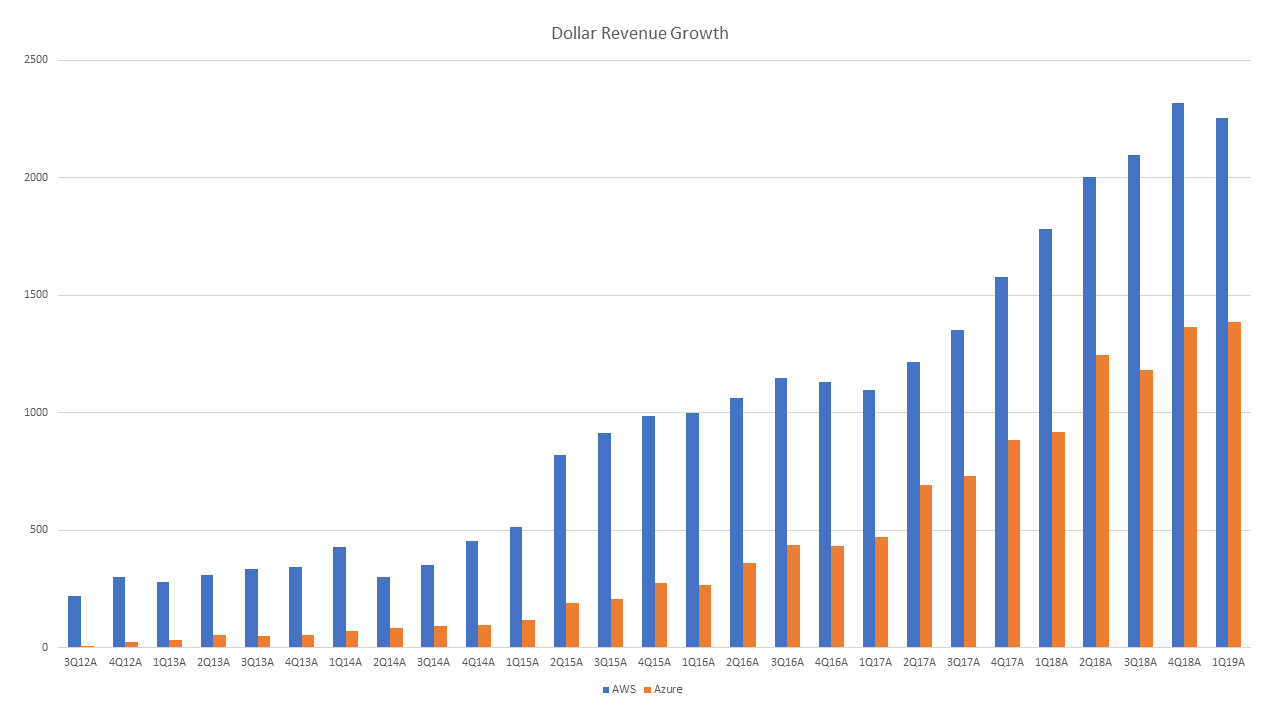
First I can understand the excitement — this is a classic and beautiful S-Curve chart here, and the higher bars helps put the excitement in context, the whole ecosystem is still not close to penetrated. Are we 10 or 40% there? I don’t know, but clearly, we are below 50% penetration. I also wonder what made cloud dip slightly in the ~3Q16–1Q17 period, and this is probably a useful thread to explore.
Next the thing that helps this frame is market share win each quarter. If you hypothetically added all the incremental dollar revenue growth charts of every cloud player, you would have how much the TAM grew that quarter. The share of that each quarter shows their relative market share wins or losses. What is really impressive here is that Azure’s catch-up is no slouch (if you believe the numbers, please disclose more MSFT), Azure went from growing ~20% as much dollar wise compared to Amazon, to 60% of the dollar revenue growth. I believe that is way more impressive than the YoY revenue growth chart below, which has some bonkers absolute revenue growth numbers, but doesn’t put the 16 to 18 catch-up in much context.

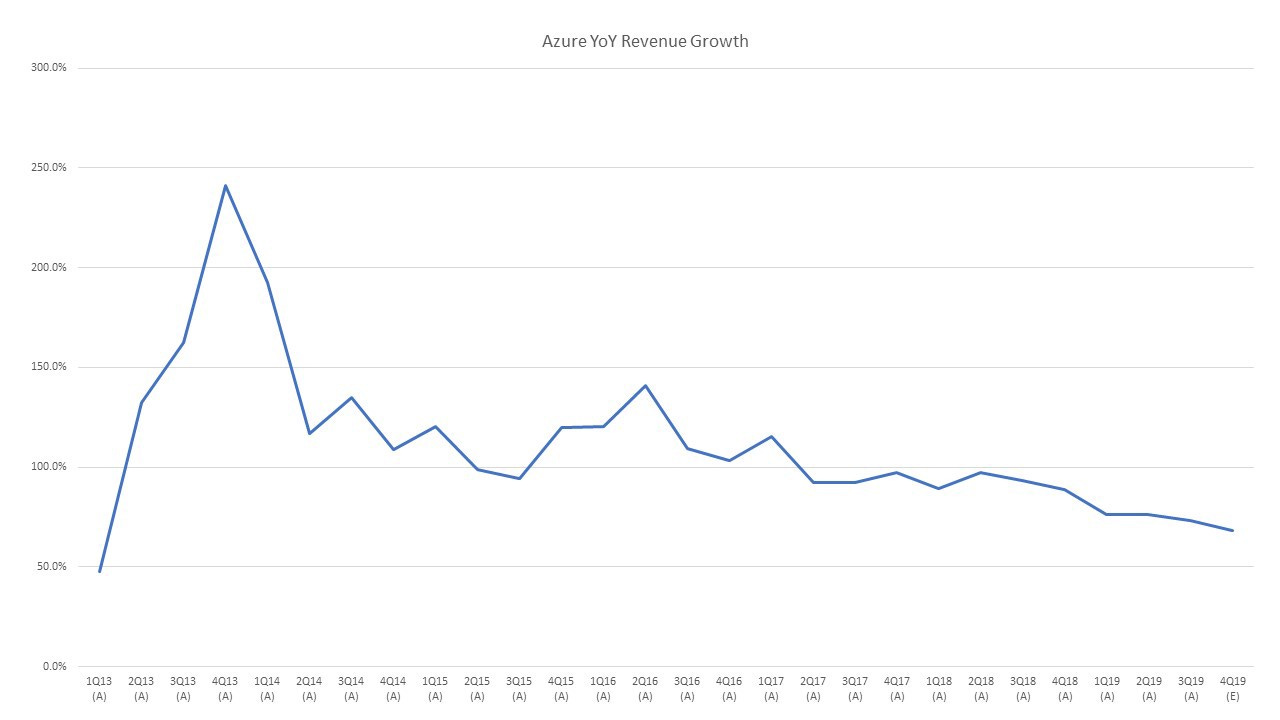
Additionally something that would be astounding would be if Azure ever grew more dollar wise in a quarter than Amazon, I would say that is the ultimate winner’s mark. If that were to happen (I’m not betting on it) — I would say AWS “lost” the cloud wars. Meanwhile using GCP’s poorly estimated annual numbers, here is the annual dollar revenue growth from GCP/Azure/AWS.

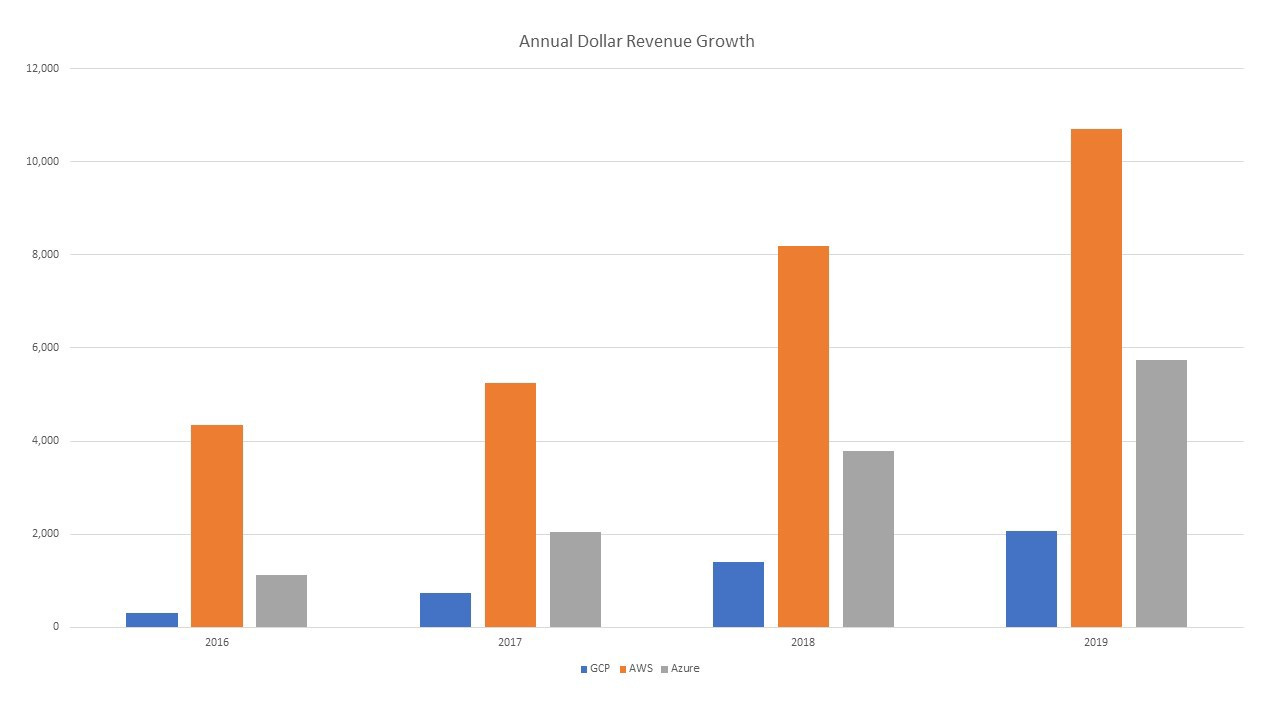
It really puts things into perspective — and for 2019 — the dollar share gains were 11%, 58%, and 31% for GCP, AWS, and Azure. Probably the correct way to think about market share gains for cloud.
Now being honest, this is an implied number at best, but is a better context generator than some large YoY revenue growth number compared against each other. Another useful way to think about dollar revenue versus just outright percentage revenue growth figures.
The Final Benefit of Dollar Revenue Growth — Thinking like the Management Team
Okay I think I got it out my system how I use dollar revenue as a kind of revenue framing metric — and this probably can be ported over to the very similar gross profit dollars that management often thinks about. Something that is also uncanny about this is that whenever I talk with a management team, I will say well do you think you’re going to grow X%, and they are like well yeah 100 million dollars in revenue growth.
I think this is a subtle but important part of dollar revenue as a framework, the shift from thinking of businesses in a spreadsheet, versus thinking of businesses as well, a business in DOLLARS. I don’t think management is thinking in percentage revenue, but in dollars of revenue. Which honestly is no freaking surprise if you’re not an excel monkey like me. They can’t linearly scale their business like our models can, with just a percentage growth of last year’s opex to support next year’s growth.
Thinking in terms of dollar revenues also gets you closer to unit economics, and while most businesses target growth in percentages, its done one goal at a time often measured simply in dollars. Quotas, sales reps, what have you, likely measured in dollars.
For a business at scale, growing 100 million dollars of revenue means hiring sales people to the tune of 10 million dollars a year in operating expenses (this is illustrative). That’s effort and time, that’s a HR hiring bonanza, that’s a lot of dollars. And dollar revenue aligns your thinking with how most managers are probably incentivized and think, hitting a dollar revenue or EBITDA target.
I think all together this makes sense on why dollar revenue growth is a really solid tool for most growth investors, and honestly the little to no talk about it as a framing tool makes me wonder what the heck am I missing?
I hope you find this post helpful. This is kind of just an amalgamation of thoughts I’ve had for a bit, and the framing tools I mention here have become a more important part of my modeling / framing toolkit as of late. Feedback of course is appreciated.
]]>So, enter stage left: Discord, which is in my opinion the darkest of horses for any kind of platform, and is generally slept upon by most writ large but has an interesting shot to becoming something bigger or at least a design pattern for something more.
What even is Discord?
Discord is a VOIP and IM platform for communities online. Discord functions organizes its groups into a community (server) and then further into channels about topics, which can be grouped into similar channels based on interest. You can private message, share files, voice and video call, and collaborate on shared uses. You usually join a Discord by either an email invite or clicking a link to join. There additionally is a large community of third-party apps that you can integrate into your servers and channels to add more features.
So without going on any further, I can feel you asking your question from here, “wait isn’t this just slack?” Yes. But no, but yes? It’s slack but for gamers.
Okay so what’s the big freaking deal, I thought slack and teams were taking over the world, who the hell is Discord and why should I care? It’s just gamers tinkering on the internet, right?
Yes. And more yes! More interesting than gamers is that Discord is quickly becoming a platform for small internet communities – and the long tail of internet niche communities is always something to be excited about.
How do Discord and Slack Compare?
Everyone loves tables. Here is a great table from this very nice comparison source.
If you summarize the above summaries – more freemium, unlimited chat history.
Oh a quick quantitative comparison from this website
Slack has ~12+ million DAU, 1 billion weekly messages, and 1000+ employees
Discord has ~250+ million users, ~7 billion dail, and ~100+ employees
These numbers are not like to like - discord has different disclosures. But I do think its fair to say that the scale of Discord is 5x bigger while having 1/10th the employees and the last valuation round was at 2 billion versus slacks 12 billion valuation? Seems kind of underrated if you ask me.
Why is Discord So Different?
So, the 2 key features I can really point out that makes Discord so much better in my opinion is
1) Unlimited free tiers
2) Unlimited Channel Permissions
The first one is simple to understand, unlimited. You can’t create sprawling internet communities without unlimited messages and a history to search and communicate overtime. You can’t build anything if the Discord’s past is being removed once it hits 10k posts. The communities that I have joined with 1000s of members that are free slacks end up as Q&A message boards sorted by channel, but really don’t create lasting long-term relationships that a deep history of Discord use can. Makes sense.
The second and much more important function is Channel permissions. If I had to choose a killer “second act” for slack and slack-like functions, it’s multiple permissions and roles. You can have unlimited roles in my tests – and this can create some interesting logic structures when paired with simple bots.
Let’s put for example the basis “read only” channel – that usually ends up as a basic announcement and FAQ channel. I’m going to take a screenshot of an example of one of my favs, @coretek’s Discord channel
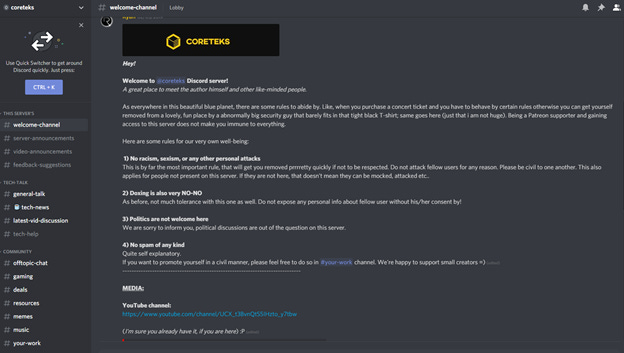

That’s pretty cool huh – Discord with a read only is a Wikipedia function huh? You could even do show only wikis based on roles so that each person who enters the Discord can be assigned a role and have a defined subset of Discords that they are shown and able to chat in. Nifty! But let’s be real here – this is not the “future of work” that I hyped in the title, just connecting the internet. No the rabbit hole goes much deeper. Let me introduce you to “shut up and que”.
“Shut up and Que” (SUAQ) is a classic world of warcraft Discord for cross server collaboration for a PVP 40 vs 40 battleground. While SUAQ shares a lot of the same attributes of many Discords of subreddits and niche communities alike, the one thing that it really does better than anything else I have ever seen is use bots and roles to create some kind of futuristic amazing meta-layer tool. Let’s walk through what it is.
First you join this Discord via invite only – pretty par for the course in an internet community. Next you have an intensive onboard process. This once again pretty much typical of most Discord FAQ processes.


The “cool part” is the following video. Once you’re all set up, you press a button in game, which then puts you into a queue to be sorted into a battleground. When you are assigned a battleground, you then put “!AV ##” into the sorting room in Discord and you are placed in a voice chat for that specific battleground. You make the choice to choose if you want to take the game (depending on your team composition) or not, and if you do you press accept, you chat with ~30 strangers on the internet and because you almost always have a communication edge over the other team, you frequently win. #informationedge much?
This is a pretty typical matchmaking system, but to me the real magic is in the following video.

Watching the !AV ## (the logic behind the sorter) in real time makes you appreciate how massive this operation really is. This is 6000 people in the server, ~100-200 waiting to queue at any given time, with ~300 people in games at any given point. Going on 24/7, automagically sorting strangers across the internet to collaborate on a relatively hard problem. The best part is this was live 2 weeks after the feature of the game got launched, and it’s pretty stable considering its load. I would call that success.
This is a really sophisticated sorting tool, but made in someone else’s platform and definitely not from the ground up. While there is some coding involved, this feels a lot more “low code” than other solutions, and overall a very satisfyingly good system. The channel permissions let you be sorted into different roles, in different servers, with a bot that has a whole different level of control than the users, and all of this layered logic is the backbone of making this system work.
Let’s take a big ole step back here for a second. Someone put up a stable and usable sorting queue in 2 weeks and it’s being used by hundreds of people 24/7, all with a simple bot and some permissions. This. Is. Bonkers.
This is by far the coolest thing I’ve seen on the internet recently, and once I saw it my mind has been racing on what you can do with a lot of permissions, integrations into other systems, and some light levels of programmability. With a simple Discord bot you could probably make the note taking tool of the year – with $tags to sort all my messages into stock specific Discord channels for example.
But this framework is just a skeleton of some really interesting design patterns, and when I saw it I instantly thought of a decentralized mass of workers – and that’s why future of work really comes to mind for me. Let’s explore.
Design Patterns for Future of Work / Other Interesting Uses
First off, as all good posts have a graphic (lol) – here is mine below. This just summarizes and abstracts what happens above but in an easier to follow format. And we can take a step back from “video games” and into a more generalist “task”, I think a bigger “aha” takes place.


This basic design pattern is probably something akin to a call center right now. You show up to work – login to your desktop, start taking calls and are sorted, repeat over and over and over. You could arguably do this in Discord. NEAT.
But what if we take something and generalize it a bit more? What if there are different tasks and different roles, and you can go to a central place, be put into a “custom” end state for your role, and then change your role as your role is needed and you are shown / hidden resources and grouped with the people you need to collaborate with as needed. The graphic looks something like this.
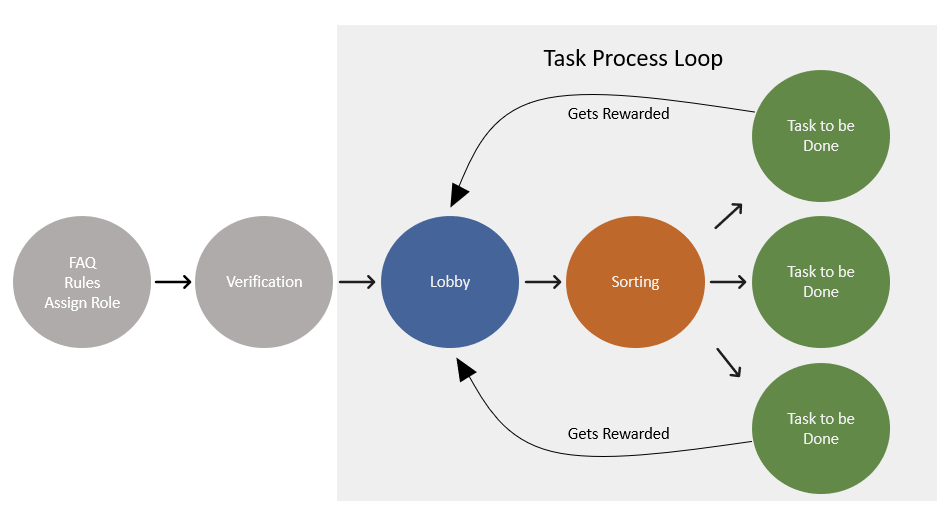
This is pretty much what slack dreams to be in my opinion. There is just so much going on here that you could design with this. This could be a pickup mechanical turk lobby, a gig-economy app, a volunteer sorting thingy. The possibilities are endless, and somehow come together in a really seamless place.
In a hypothetical world, you could get a Discord (or whatever is next) link for your new job tomorrow – you read some wiki and meta info, sort yourself into your role you’d, and then are grouped with the people who you need to collaborate with on a need be basis. All wrapped in one platform. Maybe you have an HR complaint - drop it in #HR where you can’t read the messages but they can, so it’s a blind 1 way conversation. Maybe there is a #help channel, where you ping you write your problems and the bot pings people who have expertise based on keywords. There’s a lot of things you can do with this basic design.
And remember, something that is interesting about slack and Discord is they kind of carry a slew of all the software of the past. They kind of are a blend of email, word, dropbox, and at least in teams you can even open excel/word/etc in the team’s browser. Suddenly this looks like a single terminal where you can do sophisticated roles in a decentralized manner. This is the meta-layer that I think the arc of collaboration (great post – please read) is looking for.
It does make sense that a meta-layer for decentralized work would emerge from an activity that never happened in-person to begin with; gaming. So keep your eyes out for Dark Horse Discord, it might just surprise us all.
And now to be clear do I think Discord “wins” or somehow ends up becoming a terminal for all things? Discord probably does not do this outside of gaming. But I do think that 1) Slack will copy some of this stuff and 2) a messaging first terminal will end up being a compelling future of work hub. Thanks for reading.

